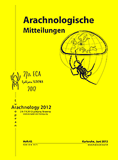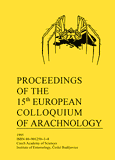31. ESA, Vac, Hungary 2018
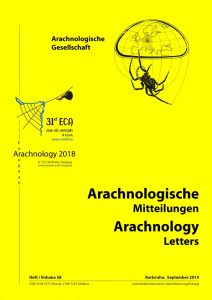 Samu F., Blick T. & Dolejš, P. (eds), 2019:
Samu F., Blick T. & Dolejš, P. (eds), 2019:
European Arachnology 2018 (Proceedings of the 31st European Congress of Arachnology, Vac, Hungary, 08–13 July 2018)
Arachnologische Mitteilungen 58: parts (PDF)
Table of contents with separate PDFs
– Cover and contents (PDF)
– Samu F., 2019: Preface to the Proceedings of the 31th European Congress of Arachnology, Vác, Hungary, 2018 July 8-13. Arachnologische Mitteilungen 58: i–iv (PDF)
– Růžička V. & Růžička A., 2019: Three-dimensional modelling in arachnology as exemplified using Porrhomma-species (Araneae: Linyphiidae). Arachnologische Mitteilungen 58: 1–3 (PDF)
– Šťáhlavský F. & Dolejš P., 2019: Catalogue of the pseudoscorpions (Pseudoscorpiones) in František Miller’s collection (Department of Zoology, National Museum, Prague). Arachnologische Mitteilungen 58: 18–22 (PDF)
– Bali L., Andrési D., Tuba K. & Szinetár C., 2019: Comparing pitfall trapping and suction sampling data collection for ground-dwelling spiders in artificial forest gaps Arachnologische Mitteilungen 58: 23–28 (PDF)
– Drisya-Mohan O.M., Kashmeera N.A. & Sudhikumar A.V., 2019: Is cooperation in prey capture flexible in the Indian social spider Stegodyphus sarasinorum? Arachnologische Mitteilungen 58: 97–102 (PDF)
30. ESA, Nottingham, United Kingdom 2017
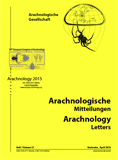 Logunov D.V., Goodacre S., Blick T. & Dolejš, P. (eds), 2018:
Logunov D.V., Goodacre S., Blick T. & Dolejš, P. (eds), 2018:
European Arachnology 2017 (Proceedings of the 30th European Congress of Arachnology, Nottingham, 20–25 August 2017)
Arachnologische Mitteilungen 55: parts (PDF)
Table of contents with separate PDFs
– Cover and contents (PDF)
– Goodacre S. & Logunov D., 2018: Preface to the Proceedings of the 30th European Congress of Arachnology, Nottingham, 2017 August 20-25. Arachnologische Mitteilungen 55: i–ii (PDF)
– Guariento L.A., Bonvicini M.C., Ballarin L., Devincenzo U., Gardini G., Moretto E., Pantini P. & Nicolosi P., 2018: Giovanni Canestrini’s heritage at the Zoology Museum of Padova University (Italy): a rediscovery of his arachnological collections and described species. Arachnologische Mitteilungen 55: 36–41 (PDF)
– Marusik Y.M., 2018: Supraspecific names in spider systematic and their nomenclatural problems. Arachnologische Mitteilungen 55: 42–45 (PDF)
– Dolejš P. & Hanko M., 2018: Ontogenetic development and reproduction of Zorocrates guerrerensis (Araneae: Zoropsidae). Arachnologische Mitteilungen 55: 46–51 (PDF) (WMV supplement) (PDF incl WMV)
– Bosmans R. & Oger P., 2018: On two cases of male dimorphism in dwarf spiders (Araneae: Linyphiidae). Arachnologische Mitteilungen 55: 52–56 (PDF)
29. ESA, Brno, Czech Republic 2015
 Pekár S., Blick T. & Buchholz S. (eds), 2016:
Pekár S., Blick T. & Buchholz S. (eds), 2016:
European Arachnology 2016 (Proceedings of the 29th European Congress of Arachnology, Brno, 24–28 August 2015)
Arachnologische Mitteilungen 51 + 52: parts (PDF)
Table of contents with separate PDFs
– Cover and contents (PDF)
– Pekár S., 2016: Preface to the Proceedings of the 29th European Congress of Arachnology, Brno, 2015 August 24 – 28. Arachnologische Mitteilungen 51: i–iii (PDF)
– Dolejš P., 2016: A collection of sea spiders (Pycnogonida: Pantopoda) in the National Museum, Prague (Czech Republic). Arachnologische Mitteilungen 51: 12–15 (PDF)
– Gavish-Regev E., Aharon S., Armiach I. & Lubin Y., 2016: Cave survey yields a new spider family record for Israel. Arachnologische Mitteilungen 51: 39–42 (PDF)
– Růžička V. & Dolanský J., 2016: Catching of spiders in shallow subterranean habitats in the Czech Republic. Arachnologische Mitteilungen 51: 43–48 (PDF)
– Machač O. & Tuf I.H., 2016: Spiders and harvestmen on tree trunks obtained by three sampling methods. Arachnologische Mitteilungen 51: 67–72 (PDF)
– Fedoriak M., Voloshyn V. & Moscaliuc L.A., 2016: Scientific heritage of Alexandru Roşca: publications, spider collection, described species. Arachnologische Mitteilungen 51: 85–91 (PDF)
– Kubcová L. & Dolejš P., 2016: In memoriam Prof. RNDr. Jan Buchar, DrSc. (1932–2015). Arachnologische Mitteilungen 51: iv–xi (PDF)
– Niba A.S. & Yekwayo I., 2016: Epigaeic invertebrate community structure in two subtropical nature reserves, Eastern Cape, South Africa: Implications for conservation management. Arachnologische Mitteilungen 52: 7–15 (PDF)
– Armiach I., Bernstein I., Tang Y., Dayan T. & Gavish-Regev E., 2016: Activity-density data reveal community structure of Lycosidae at a Mediterranean shrubland. Arachnologische Mitteilungen 52: 16–24 (PDF)
28. ESA, Torino, Italy 2014
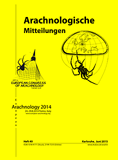 Isaia M., Blick T. & Buchholz S. (eds), 2015:
Isaia M., Blick T. & Buchholz S. (eds), 2015:
European Arachnology 2014 (Proceedings of the 28th European Congress of Arachnology, Torino, 24–29 August 2014)
Arachnologische Mitteilungen 49: 1–54 (PDF)
Table of contents with separate PDFs
– Cover and contents (PDF)
– Isaia M., 2015: Preface to the section of the Proceedings of the 28th European Congress of Arachnology, Torino, 2014 Aug. 24 – 29. Arachnologische Mitteilungen 49: i–iv (PDF)
– Dolejš P. & Vaňousová K., 2015: A collection of horseshoe crabs (Chelicerata: Xiphosura) in the National Museum, Prague (Czech Republic) and a review of their immunological importance. Arachnologische Mitteilungen 49: 1–9 (PDF)
– Tropea G., Fet V., Parmakelis A., Kotsakiozi P. & Stathi I., 2015: A new species of Euscorpius (Scorpiones: Euscorpiidae) from southern Bulgaria. Arachnologische Mitteilungen 49: 10–20 (PDF)
– Gardini G., 2015: The species of the pseudoscorpion genus Pseudoblothrus (Pseudoscorpiones: Syarinidae) in Italy (on Italian pseudoscorpions XLVIII). Arachnologische Mitteilungen 49: 21–33 (PDF)
– Zakharov B. & Ovtsharenko V., 2015: The covering setae of ground spiders (Araneae: Gnaphosidae). Arachnologische Mitteilungen 49: 34–46 (PDF)
– Rossi A., 2015: Clarification of the type locality of Pandinus ulderigoi with notes on the scorpions protected by CITES (Scorpiones: Scorpionidae). Arachnologische Mitteilungen 49: 47–54 (PDF)
27. ESA, Ljubljana, Slovenia 2012
Kuntner M., Blick T. & Buchholz S. (eds) 2013:
European Arachnology 2012 (Proceedings of the 27th European Congress of Arachnology, Ljubljana, 2–7 September 2012)
Arachnologische Mitteilungen 45: 1–20 (PDF)
Table of contents with contents PDFs
– Cover and contents (PDF)
– Kuntner M. 2013: Preface. Arachnologische Mitteilungen 45:1–3 (PDF)
– Deltshev C. 2013: On the identity of the poorly known spider species Zelotes strandi (Araneae: Gnaphosidae). Arachnologische Mitteilungen 45: 4–7 (PDF)
– Koponen S. 2013: Ground-living spiders in wooded habitats under human influence on an island in Finland. Arachnologische Mitteilungen 45: 8–14 (PDF)
– Zakharov B. & Ovtcharenko V. 2013: Male palp organ morphology of three species of ground spiders (Araneae, Gnaphosidae). Arachnologische Mitteilungen 45: 15–20 (PDF)
26. ESA, Sede-Boker, Israel 2011
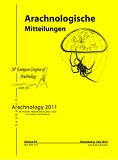 Lubin Y., Gavish-Regev E., Blick T. & Buchholz S. (eds) 2012:
Lubin Y., Gavish-Regev E., Blick T. & Buchholz S. (eds) 2012:
European Arachnology 2011 (Proceedings of the 26th European Congress of Arachnology, Sede Boqer, 4–8 September 2011)
Arachnologische Mitteilungen 43: 1–89 (PDF)
Table of contents with separate PDFs
– Cover and contents (PDF)
– Lubin Y. & Gavish-Regev E., 2012: Preface. Arachnologische Mitteilungen 43: 1–4 (PDF)
– Bosmans R. & van Keer J., 2012: On the spider species described by L. Koch in 1882 from the Balearic Islands (Araneae). Arachnologische Mitteilungen 43: 5–16 (PDF)
– Chiarle A., Kovařík F., Levi L. & Gavetti E., 2012: The scorpion collections (Arachnida, Scorpiones) held in the Museo Regionale di Scienze Naturali of Turin (Italy). Arachnologische Mitteilungen 43: 17–23 (PDF)
– Decae A.E., 2012: Geography-related sub-generic diversity within the Mediterranean trapdoor spider genus Nemesia (Araneae, Mygalomorphae, Nemesiidae). Arachnologische Mitteilungen 43: 24–28 (PDF)
– Dunlop J.A., Krüger J. & Alberti G., 2012: The sejugal furrow in camel spiders and acariform mites. Arachnologische Mitteilungen 43: 29–36 (PDF)
– Fedoriak M., Rudenko S., Iaroshynska O. & Zhukovets E., 2012: Spiders (Araneae) of Chernivtsi City (Ukraine). Arachnologische Mitteilungen 43: 37–50 (PDF)
– Geay C., Leborgne R., François O. & Pasquet A., 2012: Maintenance of polymorphism in the orb weaving spider species Agalenatea redii (Araneae, Araneidae). Arachnologische Mitteilungen 43: 51–57 (PDF)
– Helsdingen P.J. van, 2012: Spiders in Fauna Europaea: dual use of the database. Arachnologische Mitteilungen 43: 58–62 (PDF)
– Jäger P., 2012: Observations on web-invasion by the jumping spider Thyene imperialis in Israel (Araneae: Salticidae). Arachnologische Mitteilungen 43: 63–65 (PDF)
– Polchaninova N.Y., 2012: Assemblages of herb-dwelling spiders (Araneae) of various steppe types in Ukraine and Central Chernozem of Russia. Arachnologische Mitteilungen 43: 66–78 (PDF)
– Toscani C., Leborgne R. & Pasquet P., 2012: Behavioural analysis of web building anomalies in the orb-weaving spider Zygiella x-notata (Araneae, Araneidae). Arachnologische Mitteilungen 43: 79–83 (PDF)
– Wetter M.B., Wernisch B. & Toft S., 2012: Tests for attraction to prey and predator avoidance by chemical cues in spiders of the beech forest floor. Arachnologische Mitteilungen 43: 84–89 (PDF)
25. ESA, Alexandroupoli, Greece 2009
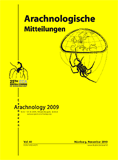 Chatzaki M., Blick T. & Finch O.-D. (eds) 2011:
Chatzaki M., Blick T. & Finch O.-D. (eds) 2011:
European Arachnology 2009 (Proceedings of the 25th European Congress of Arachnology, Alexandroupoli, 16–21 August 2009)
Arachnologische Mitteilungen 40: 1–109
Table of contents with separate PDFs
– Cover and contents (PDF)
– Chatzaki M. 2011: Preface. Arachnologische Mitteilungen 40: 1–4 (PDF)
– Blick T. – Abundant and rare spiders on tree trunks in German forests (Arachnida, Araneae) 5–14 (PDF)
– Bosmans R. 2011: On some new or rare spider species from Lesbos, Greece (Araneae: Agelenidae, Amaurobiidae, Corinnidae, Gnaphosidae, Liocranidae). Arachnologische Mitteilungen 40: 15–22 (PDF)
– Deltshev C. 2011: The faunistic diversity of cave-dwelling spiders (Arachnida, Araneae) of Greece. Arachnologische Mitteilungen 40: 23–32 (PDF)
– Deltshev C., Lazarov S., Naumova M. & Stoev P. 2011: A survey of spiders (Araneae) inhabiting the euedaphic soil stratum and the superficial underground compartment in Bulgaria. Arachnologische Mitteilungen 40: 33–46 (PDF)
– Dunlop J.A. & Mitov P.G. 2011: The first fossil cyphophthalmid harvestman from Baltic amber. Arachnologische Mitteilungen 40: 47–54 (PDF)
– Helsdingen P.J. van vpiders in a hostile world (Arachnoidea, Araneae). Arachnologische Mitteilungen 40: 55–64 (PDF)
– Komposch C. 2011: Endemic harvestmen and spiders of Austria (Arachnida: Opiliones, Araneae). Arachnologische Mitteilungen 40: 65–79 (PDF)
– Koponen S. 2011: Ground-living spiders (Araneae) at polluted sites in the Subarctic. Arachnologische Mitteilungen 40: 80–84 (PDF)
– Lubin Y., Angel N. & Assaf N. 2011: Ground spider communities in experimentally disturbed Mediterranean woodland habitats. Arachnologische Mitteilungen 40: 85–93 (PDF)
– Piterkina T.V. 2011: Spatial and temporal structure of the spider community in the clay semi-desert of western Kazakhstan. Arachnologische Mitteilungen 40: 94–104 (PDF)
– Samu F., Szinetár C., Szita E., Fetykó F. & Neidert D. 2011: Regional variations in agrobiont composition and agrobiont life history of spiders (Araneae) within Hungary. Arachnologische Mitteilungen 40: 105–109 (PDF)
24. ESA, Bern, Switzerland 2008
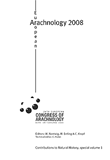 Nentwig W., Entling M. & Kropf C. (eds) 2010:
Nentwig W., Entling M. & Kropf C. (eds) 2010:
European Arachnology 2008.
Contributions to Natural History, special volume 1. ISSN 1660-9972
Natural History Museum Bern, 1–175
Table of contents with seperate PDFs
– Cover and contents (PDF)
– Nentwig W., Entling M. & Kropf C., 2010: Preface. Contributions to Natural History 1: 5–7 (PDF)
– Blick T., 2011: Spider coenoses in strict forest reserves in Hesse (Germany). 11–29 (PDF)
– Chiarle A., Isaia M. & Castellano S., 2010: New findings on the courtship behavior of Pardosa wagleri (Hahn, 1822) and P. saturatior Simon, 1937 (Araneae, Lycosidae), a pair of sibling species. Contributions to Natural History 1: 31–39 (PDF)
– Decae A.E., 2010: Patterns of distribution and diversity in European mygalomorph spiders. 41–50 (PDF)
– Deeleman-Reinhold C. & Floren A., 2010: Crab spiders, tree canopy, and biodiversity in tropical East Asia (Araneae: Thomisidae). Contributions to Natural History 1: 51–58 (PDF)
– Dunlop J.A., Sempf C. & Wunderlich J., 2010: A new opilioacarid mite in Baltic amber. Contributions to Natural History 1: 59–70 (PDF)
– Hore U. & Uniyal V.P., 2010: Influence of space, vegetation structure and microclimate on spider (Araneae) species composition in Terai Conservation Area, India. Contributions to Natural History 1: 71–77 (PDF)
– Isaia M., Beikes S., Paschetta M., Sarvajayakesavalu S. & Badino G., 2010: Spiders as potential biological controllers in apple orchards infested by Cydia spp. (Lepidoptera: Tortricidae). Contributions to Natural History 1: 79–88 (PDF)
– Isaia M., Lana E. & Pantini P., 2010: Ecology and distribution of the genus Troglohyphantes Joseph, 1881 in the Western Italian Alps. Contributions to Natural History 1: 89–97 (PDF)
– Koponen S., 2010: Arachnology in Finland. 1. From Laxmann to Palmgren. Contributions to Natural History 1: 99–103 (PDF)
– Kronestedt T., 2010: Carl Clerck and what became of his spiders and their names 105–117 (PDF)
– Larsen B. & Toft S., 2010: Value of the aphid Hyalopterus pruni as food for the spider Clubiona phragmitis. Contributions to Natural History 1: 119–123 (PDF)
– Majer M., Kelava I., Lugic E. & Zec M., 2010: Araneofauna of the Mediterranean island of Vis (Croatia). Contributions to Natural History 1: 125–127 (PDF)
– Milasowszky N., Hepner M., Hörweg C. & Rotter D., 2010: Influence of scrub encroachment and rank vegetation development on the epigeic spider fauna (Arachnida: Araneae) of dry meadows in the “Untere Lobau” (National Park Donau-Auen, Vienna, Austria). Contributions to Natural History 1: 129–146 (PDF)
– Rensch M., Volkmar C. & Spilke J., 2010: Aerial dispersal of spiders in central east Germany: Modelling of meteorological and seasonal parameters. Contributions to Natural History 1: 147–152 (PDF)
– Samu F., Szita E. & Botos E., 2010: Short- and longer-term colonization of alfalfa by spiders — a case study into the succession of perennial fields. Contributions to Natural History 1: 153–163 (PDF)
– Sudhikumar A., Maelfait J.P., Lens L., Hendrickx F. & Sebastian P.A., 2010: African and Southeast Asian elements in the spider fauna of the Western Ghats of India. Contributions to Natural History 1: 165–175 (PDF)
23. ESA, Sitges, Spain 2006
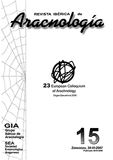 Ribera C., Arnedo M.A. (eds) 2007:
Ribera C., Arnedo M.A. (eds) 2007:
European Arachnology 2006. ISSN 1576-9518
Revista Ibérica de Aracnología 15: 1-142
Table of contents with separate PDFs
– Ribera C., Arnedo M.A., 2007: Foreword. Revista Ibérica de Aracnología 15: 3–8 (PDF)
– Dunlop J.A., Harms D. & Penney D., 2007: A fossil tarantula (Araneae: Theraphosidae) from Miocene Chiapas amber, Mexico. Revista Ibérica de Aracnología 15: 9–17 (PDF)
– Haupt J., 2007: An organ of stridulation in east Asian hexathelid spiders (Araneae, Mygalomorphae). Revista Ibérica de Aracnología 15: 19–23 (PDF)
– Lazarov S., 2007: A new spider species, Harpactea asparuhi sp. nov., from Bulgaria (Araneae: Dysderidae). Revista Ibérica de Aracnología 15: 25–27 (PDF)
– Jose K.S. & Sebastian P.A., 2007: Description of two mygalomorph spiders from south India (Araneae: Barychelidae, Theraphosidae). Revista Ibérica de Aracnología 15: 29–34 (PDF)
– Zaragoza J.A., 2007: On the status of the subspecies of Roncocreagris galeonuda (Pseudoscorpiones: Neobisiidae): importance of the chelal microsetae pattern. Remarks on the genus Roncocreagris. Revista Ibérica de Aracnología 15: 35–46 (PDF)
– Talarico G., Palacios-Vargas J.G. & Alberti G., 2007: Taste while chewing? Sensory structures in the chelicerae of Pseudocellus pearsei (Chamberlin & Ivie, 1938) (Ricinulei, Arachnida). Revista Ibérica de Aracnología 15: 47–53 (PDF)
– Walter A., 2007: Are web stabilimenta attractive to praying mantids?. Revista Ibérica de Aracnología 15: 55–61 (PDF)
– Jiménez-Salinas E. & Corcuera-Martínez del Río P., 2007: Inflorescences and plant selection by the green lynx spider Peucetia viridans (Hentz) in a dry forest of western Mexico. Revista Ibérica de Aracnología 15: 63–66 (PDF)
– Seyfulina R.R. & Bakker D. de, 2007: Linyphiid Spiders (Araneae, Linyphiidae) from African forest canopies. Revista Ibérica de Aracnología 15: 67–79 (PDF)
– Biteniekytė M. & Relys V., 2007: Epigeic spider communities of a peat bog and adjacent habitats. Revista Ibérica de Aracnología 15: 81–87 (PDF)
– Uniyal V.P. & Hore U., 2007: Spider assemblage in the heterogeneous landscape of Terai Conservation Area, India. Revista Ibérica de Aracnología 15: 89–95 (PDF)
– Koponen S., 2007: Spiders from groves in the southwestern archipelago of Finland (Araneae). Revista Ibérica de Aracnología 15: 97–104 (PDF)
– Pétillon J., CourtialC., Canard A. & Ysnel F., 2007: First assessment of spider rarity in Western France. Revista Ibérica de Aracnología 15: 105–113 (PDF)
– El-Hennawy H.K., 2007: Arachnids of Elba protected area in the southern part of the eastern desert of Egypt. Revista Ibérica de Aracnología 15: 115–121 (PDF)
– Mitov P.G., 2007: Opiliones (Arachnida) from the southern Dobrudzha (NE Bulgaria) and its adjacent regions. Revista Ibérica de Aracnología 15: 123–136 (PDF)
– Nolan M., 2007: An ‘Expert System’ approach to digitising ecological information on spiders for habitat assessment. Revista Ibérica de Aracnología 15: 137–142 (PDF)
22. ESA, Blagoevgrad, Bulgaria 2005
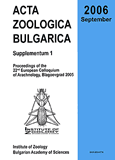 Deltshev C. & Stoev P. (eds) 2006:
Deltshev C. & Stoev P. (eds) 2006:
European Arachnology 2005. ISSN 0324-0770
Acta Zoologica Bulgarica, supplementum No. 1: 1-343 (PDF)
Table of contents with separate PDFs
– Cover and contents (PDF)
– Deltshev C., 2006: Foreword. Acta Zoologica Bulgarica, supplementum No. 1: 3 (PDF)
– Colloquium Photo. 4–5
– van Helsdingen P.J., 2006: In memoriam Konrad Thaler. Acta Zoologica Bulgarica, supplementum No. 1: 7–8 (PDF)
PALEONTOLOGY
– Dunlop J.A., 2006: New ideas about the euchelicerate stem-lineage. Acta Zoologica Bulgarica, supplementum No. 1: 9–23 (PDF)
– Penney D. & Selden P.A., 2006: Assembling the Tree of Life-Phylogeny of Spiders: a review of the strictly fossil spider families. Acta Zoologica Bulgarica, supplementum No. 1: 25–39 (PDF)
MORPHOLOGY
– Gutjahr M., Schuster R. & Alberti G., 2006: Ultrastructure of dermal and defence glands in Cyphophthalmus duricorius JOSEPH, 1868 (Opiliones: Sironidae). Acta Zoologica Bulgarica, supplementum No. 1: 41–48 (PDF)
– Jäger P., 2006: Lengthening of embolus and copulatory duct: a review of an evolutionary trend in the spider family Sparassidae (Araneae). Acta Zoologica Bulgarica, supplementum No. 1: 49–62 (PDF)
TAXONOMY AND SYSTEMATICS
– Azarkina G.N., 2006: Four new species of the genus Aelurillus SIMON, 1884 (Araneae: Salticidae). Acta Zoologica Bulgarica, supplementum No. 1: 63–72 (PDF)
– Gnelitsa V.A., 2006: Typhochrestus longisulcus sp. n., a new spider species from the Crimean Peninsula, Ukraine (Araneae: Linyphiidae). Acta Zoologica Bulgarica, supplementum No. 1: 73–76 (PDF)
– Haupt J., 2006: On the taxonomic position of the East Asian species of the genus Ummidia THORELL, 1875 (Araneae: Qenizidae). Acta Zoologica Bulgarica, supplementum No. 1: 77–80 (PDF)
– Lazarov S., 2006: A new spider species, Harpactea samuili sp. n., from Bulgaria (Araneae: Dysderidae). Acta Zoologica Bulgarica, supplementum No. 1: 81–85 (PDF)
– Ovtsharenko V.I., Fedoryak M.M. & Zakharov B.P., 2006: Ground spiders of the genus Taieria FORSlER, 1979 in New Zealand: taxonomy and distribution (Araneae: Gnaphosidae). Acta Zoologica Bulgarica, supplementum No. 1: 87–94 (PDF)
– Snegovaya N., 2006: On the harvestman fauna of Absheron-Qobustan zone (Azerbaijan), with a description of a new species (Opiliones). Acta Zoologica Bulgarica, supplementum No. 1: 95–100 (PDF)
ECOLOGY
– Gajdoš P., 2006: Spiders of the Domica drainage area (Slovak Karst Mts.): community composition and habitat evaluation (Araneae). Acta Zoologica Bulgarica, supplementum No. 1: 101–114 (PDF)
– van Helsdingen P.J., 2006: Characteristic spider species of peat bog fenlands in the Netherlands (Araneae). Acta Zoologica Bulgarica, supplementum No. 1: 115–124 (PDF)
– Jocqué R. & Alderweireldt M., 2006: Lycosidae: the grassland spiders. Acta Zoologica Bulgarica, supplementum No. 1: 125–130 (PDF)
– Koponen S. & Koneva G.G., 2006: Spiders along a pollution gradient (Araneae). Acta Zoologica Bulgarica, supplementum No. 1: 131–136 (PDF)
– Lambeets K., Bonte D., Van Looy K., Hendrickx F. & Maelfait J.-P., 2006: Synecology of spiders (Araneae) of gravel banks and environmental constraints along a lowland river system, the Common Meuse (Belgium, the Netherlands). Acta Zoologica Bulgarica, supplementum No. 1: 137–149 (PDF)
– Piterkina T., 2006: The diel vertical migrations of herbage-dwelling spiders in clayey semi-desert of the northern Caspian Sea basin, West Kazakhstan (Araneae). Acta Zoologica Bulgarica, supplementum No. 1: 151–159 (PDF)
– Seyfulina R.R., 2006: Microhabitat effect on spider distribution in winter wheat agroecosystem (Araneae). Acta Zoologica Bulgarica, supplementum No. 1: 161–172 (PDF)
– Shaw E.M., Wheater C.P. & Langan A.M., 2006: The effects of cypermethrin on Tenuiphantes tenuis (BLACKWALL, 1852): development of a technique for assessing the impact of pesticides on web building in spiders (Araneae: Linyphiidae). Acta Zoologica Bulgarica, supplementum No. 1: 173–179 (PDF)
– Sudhikumar A.V., Mathew M.J., Sunish E. & Sebastian P.A., 2006: Seasonal variation in spider abundance in Kuttanad rice agroecosystem, Kerala, India (Araneae). Acta Zoologica Bulgarica, supplementum No. 1: 181–190 (PDF)
– Svaton J. & Gajdoš P., 2006: Spiders of Gaderska and Blatnicka Dolina valleys in the southern part of Vel’ka Fatra Mts., Slovakia (Araneae). Acta Zoologica Bulgarica, supplementum No. 1: 191–219 (PDF)
– Szinetár C. & Horváth R., 2006: A review of spiders on tree trunks in Europe (Araneae). Acta Zoologica Bulgarica, supplementum No. 1: 221–257 (PDF)
BIOGEOGRAPHY
– Marusik Y.M., Mikhailov K.G. & Guseinov E.F., 2006: Advance in the study of biodiversity of Caucasian spiders (Araneae). Acta Zoologica Bulgarica, supplementum No. 1: 259–268 (PDF)
– Polchaninova N.Y. & Prokopenko H.V., 2006: istory of study and a brief survey of the araneofauna of the Left-Bank Ukraine (Araneae). Acta Zoologica Bulgarica, supplementum No. 1: 269–280 (PDF)
– Tatole A., 2006: On the biogeography of Romanian spiders (Araneae). Acta Zoologica Bulgarica, supplementum No. 1: 281–285 (PDF)
– Topçu A., Demir H., Seyyar O. & Türkeş T., 2006: The spider fauna of the Gülek Pass (Turkey) and its environs (Araneae). Acta Zoologica Bulgarica, supplementum No. 1: 287–295 (PDF)
FAUNISTICS
– Bennett S.P. & Penney D., 2006: New spider species records for the Isle of MuIl, UK (Araneae). Acta Zoologica Bulgarica, supplementum No. 1: 297–300 (PDF)
– Komenov M., 2006: New data on jumping spiders in the Republic of Macedonia with a complete checklist (Araneae: Salticidae). Acta Zoologica Bulgarica, supplementum No. 1: 301–314 (PDF)
– Sebastian P.A., Murugesan S., Mathew M.J., Sudhikumar A.V. & Sunish E., 2006: Spiders in Mangalavanam, an ecosensitive mangrove forest in Cochin, Kerala, India (Araneae). Acta Zoologica Bulgarica, supplementum No. 1: 315–318 (PDF)
– Sudhikumar A.V., Mathew M.J., Sunish E., Murugesan S. & Sebastian P.A., 2006: Preliminary studies on the spider fauna in Mannavan shola forest, Kerala, India (Araneae). Acta Zoologica Bulgarica, supplementum No. 1: 319–327 (PDF)
– Szita E., Samu F., Szinetar C., Dudás G., Botos E., Horváth R. & Szalkovszki O., 2006: New data on the occurrence of Gnaphosa rofula (L. KOCH, 1866) and Gnaphosa mongolica SIMON, 1895 in Hungary (Araneae: Gnaphosidae). Acta Zoologica Bulgarica, supplementum No. 1: 329–334 (PDF)
– Topçu A., Seyyar O., Demir H. & Türkeş T., 2006: A contribution to the knowledge of the Turkish spider fauna (Araneae). Acta Zoologica Bulgarica, supplementum No. 1: 335–338 (PDF)
PARASITOLOGY
– Gladnishka T.K., Tasseva E.I., Christova I.S., Nikolov M.A., Lazarov S.P., 2006: Detection of Borrelia burgdorferi sensu lato, Anaplasma phagocytophilum and Spotted Fever Group Rickettsiae in ticks from the region of Sofia, Bulgaria (Acari: Parasitiformes: Ixodidae). Acta Zoologica Bulgarica, supplementum No. 1: 339–343 (PDF)
21. ESA, St. Petersburg, Russia 2003
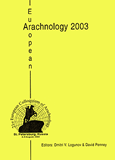 Logunov D.V. & Penney D. (eds) 2005:
Logunov D.V. & Penney D. (eds) 2005:
European Arachnology 2003.
KMK Scientific Press Ltd, Moscow, 376 pp. ISBN 5-87317-174-2
Arthropoda Selecta (Special Issue No. 1, 2005). ISSN 0136-006X
Table of contents with separate PDFs
– Cover and contents (PDF)
– Foreword 5
– List of Participants 7
– Colloquium Photo 8–9
– Stekol’nikov A.A., 2005: Professor Victor Tyshchenko (1937-1986) and his contribution to Russian arachnology. Arthropoda Selecta Spec. Issue 1: 11–19 (PDF)
– Mikhailov K.G., 2005: A brief historical overview of the development of arachnology in Russia. Arthropoda Selecta Spec. Issue 1: 21–34 (PDF)
– Bruun L.E., Michaelsen K.R., Sørensen A., Nielsen M.H. & Toft S., 2005: Mating duration of Pisaura mirabilis (Araneae: Pisauridae) depends on the size of the nuptial gift and not on male size. Arthropoda Selecta Spec. Issue 1: 35–39 (PDF)
– Deeleman-Reinhold C.L., 2005: n the taxonomic relations of lynx spiders from the canopy of a tropical Asian rainforest (Araneae: Oxyopidae). Arthropoda Selecta Spec. Issue 1: 41–52 (PDF)
– Deltshev C., 2005: A review of the family Linyphiidae (Araneae) in Bulgaria, faunistic and zoogeographical analyses. Arthropoda Selecta Spec. Issue 1: 53–66 (PDF)
– Dunlop J.A., 2005: – A spiny harvestman (Arachnida: Opiliones) from the Upper Carboniferous of Missouri, USA. Arthropoda Selecta Spec. Issue 1: 67–74 (PDF)
– Fedoryak M.M. & Evtushenko K.V., 2005: On the Lycosidae (Araneae) occurring on the pebble banks of the river Siret and its tributaries, Ciscarpathia (Ukraine). Arthropoda Selecta Spec. Issue 1: 75–78 (PDF)
– Gnelitsa V.A., 2005: Araeoncus tauricus sp.n.: a new spider species (Araneae: Linyphiidae) from the Crimea, Ukraine. Arthropoda Selecta Spec. Issue 1: 79–82 (PDF)
– Gromov A.V., 2005: Four new species of the genus Karschia Walter, 1889 (Arachnida: Solifugae: Karschiidae) from Central Asia. Arthropoda Selecta Spec. Issue 1: 83–92 (PDF)
– Guseinov E.V., 2005: Natural prey of the jumping spider Menemerus semilimbatus (Hahn, 1827) (Araneae: Salticidae), with notes on its unusual predatory behaviour. Arthropoda Selecta Spec. Issue 1: 93–100 (PDF)
– van Helsdingen P.J., 2005: The merits of a European checklist of spiders (Arachnida: Araneae). Arthropoda Selecta Spec. Issue 1: 101–106 (PDF)
– Jäger P., 2005: A study of the character ‘palpal claw’ in the spider subfamily Heteropodinae (Araneae: Sparassidae). Arthropoda Selecta Spec. Issue 1: 107–125 (PDF)
– Judson M.L.I., 2005: Baltic amber fossil of Garypinus electri Beier provides first evidence of phoresy in the pseudoscorpion family Garypinidae (Arachnida: Chelonethi). Arthropoda Selecta Spec. Issue 1: 127–131 (PDF)
– Koponen S., 2005: Effects of intensive fire on the ground-living spider fauna (Araneae) of a pine forest. Arthropoda Selecta Spec. Issue 1: 133–137 (PDF)
– Kovblyuk N.M., 2005: The spider genus Trachyzelotes Lohmander, 1844 in the Crimea, south Ukraine (Araneae: Gnaphosidae). Arthropoda Selecta Spec. Issue 1: 139–146 (PDF)
– Lehtinen P.T., 2005: Taxonomic notes on the Misumenini (Araneae: Thomisidae: Thomisinae), primarily from the Palaearctic and Oriental regions. Arthropoda Selecta Spec. Issue 1: 147–184 (PDF)
– Marusik Y.M., 2005: Fauna and populations of the petrophilous spiders (Arachnida: Araneae) of north-east Siberia and north-west Canada. Arthropoda Selecta Spec. Issue 1: 185–200 (PDF)
– Marusik Y.M. & Penney D., 2005: A survey of Baltic amber Theridiidae (Araneae) inclusions, with descriptions of six new species. Arthropoda Selecta Spec. Issue 1: 201–218 (PDF)
– Oliger T.I., 2005: Epigaeic spider assemblages of the sphagnum biotopes in Lake Ladoga region, north-west Russia. Arthropoda Selecta Spec. Issue 1: 219–224 (PDF)
– Penney D., 2005: Estimations of global extant spider family richness using neontological and palaeontological data. Arthropoda Selecta Spec. Issue 1: 225–234 (PDF)
– Pétillon J., Ysnel F., Le Gleut S., Lefeuvre J.-C. & Canard A., 2005: Responses of spider communities to salinity and flooding in a tidal salt marsh (Mont St.-Michel Bay, France). Arthropoda Selecta Spec. Issue 1: 235–248 (PDF)
– Platen R., 2005: Spider assemblages (Arachnida: Araneae) as indicators for degraded oligotrophic moors in north-east Germany. Arthropoda Selecta Spec. Issue 1: 249–260 (PDF)
– Polchaninova N.Y., 2005: Effect of hay-mowing on spider communities of the meadow steppes of the central forest-steppe (Russia and Ukraine). Arthropoda Selecta Spec. Issue 1: 261–273 (PDF)
– Seyfulina R.R., 2005: Spatial distribution of spiders (Arachnida: Araneae) in agroecosystems of the European part of Russia. Arthropoda Selecta Spec. Issue 1: 275–292 (PDF)
– Shavanova T.M., 2005: Species composition of the harvestmen (Arachnida: Opiliones) in biocoenoses of the vicinities of Minsk (Belarus). Arthropoda Selecta Spec. Issue 1: 293–295 (PDF)
– Shaw E.M., Wheater C.P. & Langan A.M., 2005: Do pesticide applications influence feeding and locomotor behaviour of Pardosa amentata (Clerck) (Araneae: Lycosidae)? Arthropoda Selecta Spec. Issue 1: 297–305 (PDF)
– Snegovaya N.Y., 2005: Preliminary notes on the harvestman fauna (Opiliones) of Azerbaijan. Arthropoda Selecta Spec. Issue 1: 307–318 (PDF)
– Tuneva T.K., 2005: A contribution on the gnaphosid spider fauna (Araneae: Gnaphosidae) of east Kazakhstan. Arthropoda Selecta Spec. Issue 1: 319–332 (PDF)
– Vanacker D., Deroose K., Van Nieuwenhuyse L., Vandomme V., Vanden Borre J. & Maelfait J.-P., 2005: The springtail Sinella curviseta: the most suitable prey for rearing dwarf spiders. Arthropoda Selecta Spec. Issue 1: 333–342 (PDF)
– Vugdelic M., Goodacre S., Smith H. & Hewitt G., 2005: Preliminary analysis of the genetic structure in the fen raft spider Dolomedes plantarius (Araneae: Pisauridae). Arthropoda Selecta Spec. Issue 1: 343–348 (PDF)
– Zonstein S.L., 2005: The spider chelicerae: some problems of origin and evolution. Arthropoda Selecta Spec. Issue 1: 349–366 (PDF)
– Zschokke S., 2005: Glue droplets in fossil spider webs. Arthropoda Selecta Spec. Issue 1: 367–374 (PDF)
20. ESA, Szombathely, Hungary 2002
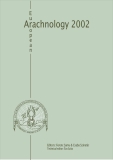 Samu F. & Szinetár C. (eds) 2004:
Samu F. & Szinetár C. (eds) 2004:
European Arachnology 2002.
Plant Protection Institute (Budapest) & Berzsenyi College (Szombathely), 356 pp. ISBN 963-214-791-X
Table of contents with separate PDFs
– Table of contents (PDF)
– Foreword 5–7 (PDF)
– Colloquium Photo 8
– Szinetár C., 2004: In memoriam Dr. Imre Loksa 11–14 (PDF)
EVOLUTION, MOLECULAR AND CLASSIC TAXONOMY
– Dunlop J., 2004: The enigmatic fossil arachnid Kustarachne tenuipes Scudder, 1890 is a harvestman 17–25 (PDF)
– Dubois J., Rollard C., Villemant C. & Gauld I.D., 2004:– The phylogenetic position of parasitoids of spiders within Pimplinae (Hymenoptera, Ichneumonidae) 27–35 (PDF)
– Le Gleut S., Vidal N., Tillier A., Ysnel F. & Canard A., 2004: Molecular and morphological systematics of the Rastelloidina (Mygalomorphae) 37–48 (PDF)
– Gurdebeke S. & Maelfait J.-P., 2004: RAMS technique fails in developing microsatellite primers for Coelotes terrestris 49–56 (PDF)
– Kubcová L., 2004: Separation of the females of Philodromus praedatus O.P.-Cambridge and Philodromus aureolus (Clerck) (Araneae: Philodromidae) 57–62 (PDF)
MORPHOLOGY AND PHYSIOLOGY
– Haupt J., 2004: The palpal organ of male spiders (Arachnida, Araneae). 65–71 (PDF)
– Bryja V., 2004: Male trimorphism in Pelecopsis mengei (Erigoninae, Linyphiidae, Araneae). 73–79 (PDF)
– De Bakker D., Gellynck K., Van Nimmen E., Mertens J. & Kiekens P., 2004: Comparative structural analysis of cocoons and cocoon silk in three spider species through Scanning Electron Microscopy. 81–87 (PDF)
– Miyazaki K. & Pass G., 2004: Morphology of the circulatory system in the sea spider, Ammothella biunguiculata (Pycnogonida, Ammotheidae), with special reference to the cephalic region. 89–92 (PDF)
FUNCTIONAL ECOLOGY
– Horváth R., Lengyel S., Szinetár C. & Honti S., 2004: The effect of exposition time and temperature on spiders (Araneae) overwintering on the bark of black pine (Pinus nigra). 95–102 (PDF)
– Guseinov E.F., 2004: Prey composition of three Thanatus species (Philodromidae, Araneae): indication of relationship between psammophily and myrmecophagy. 103–108 (PDF)
– Pedersen B.P. & Lövei G.L., 2004: Tri-trophic effects of aphid-resistant wheat on a generalist predator, Pardosa amentata. 109–115 (PDF)
– Vanacker D., Pardo S. & Maelfait J.-P., 2004: Different forms of cannibalism in the dwarf spider Oedothorax gibbosus (Blackwall, 1841). 117–126 (PDF)
ECOLOGICAL INDICATION, COMMUNITY AND POPULATION ECOLOGY
– Maelfait J.-P., Baert L., Bonte D., De Bakker D., Gurdebeke S. & Hendrickx F., 2004: The use of spiders as indicators of habitat quality and anthropogenic disturbance in Flanders, Belgium. 129–141 (PDF)
– Bell J.R., Shaw E.M. & Wheater C.P., 2004: Does stochasticity in emergent pioneer communities reduce the value of indicator species analysis? 143–150 (PDF)
– Gallé R., 2004: Assemblage structure of wolf spiders in south Hungarian grasslands. 151–156 (PDF)
– Koponen S., 2004: Microhabitats of ground-living spiders in a peat bog. 157–161 (PDF)
– Koponen S., Relys V., Weiss I. & Hoffmann J., 2004: On the phenology of peat bog spiders. 163–170 (PDF)
– Lukashevich I.G., 2004: Ecological studies on wolf spiders (Lycosidae, Araneae) in Central Belarus: seasonal activities and habitat preferences observed by pitfall trapping. 171–177 (PDF)
– Szinetár C. & Eichardt J., 2004: Larinia species (Araneidae, Araneae) in Hungary. Morphology, phenology and habitats of Larinia jeskovi Marusik, 1986, Larinia elegans Spassky, 1939, and Larinia bonneti Spassky, 1939. 179–186 (PDF)
BIODIVERSITY AND INVENTORIES
– Bonte D., Maelfait J.-P. & Léon Baert L., 2004: Determining spider (Araneae) species richness in fragmented coastal dune habitats by extrapolation and estimation. 189–197 (PDF)
– Cardoso P., de Oliveira N.G., Silva I. & Serrano A.R.M., 2004: Higher taxa surrogates versus surrogate groups of spider biodiversity. 199–205 (PDF)
– Hänggi A., Nentwig W., Kropf C. & Blick T., 2004: www.araneae.unibe.ch Central European Spiders – Determination Key. 207–213 (PDF)
– van Helsdingen P.J., 2004: International biodiversity initiatives, with special emphasis on Fauna Europaea. 215–219 (PDF)
– Růžička V. & Buchar J., 2004: Notes to the Catalogue of spiders of the Czech Republic. 221–224 (PDF)
BIOGEOGRAPHY AND FAUNISTICS
– Komposch C., 2004: The harvestman fauna of Hungary (Arachnida, Opiliones). 227–242 (PDF)
– Chatzaki M., Thaler K. & Mylonas M., 2004: Gnaphosidae of Crete: taxonomy and distribution. 243–249 (PDF)
– Kovblyuk M.M., 2004: A survey of spider species with Crimeo-Caucasian disjunct ranges (Arachnida, Araneae). 251–258 (PDF)
– Lazarov S.P., 2004: A review of the family Dysderidae (Araneae) in Bulgaria. Faunistic and zoogeographical analysis. 259–265 (PDF)
– Chvátalová I., 2004: Arachnofauna of the Velká Kotlina Cirque (Hrubý Jeseník Mountains). 267–274 (PDF)
– Svaton J. & Gajdoš P., 2004: Spiders of peatland ecosystems of the Horná Orava region (Slovakia). 275–284 (PDF)
– Bruun L.D. & Toft S., 2004: Epigeic spiders of two Danish peat bogs. 285–302 (PDF)
– Szinetár C., Horváth R. & Eichardt J., 2004: Chrysso nordica (Theridiidae, Araneae) found in Eastern Hungary is a new spider species for Central Europe. 303–307 (PDF)
AGRICULTURAL AND URBAN ECOLOGY
– Shaw E.M., Wheater C.P. & Langan A.M., 2004: Vegetation structure and spider behaviour: implications for brassica crops. 311–318 (PDF)
– Szita E., Samu F., Fetykó K. & Szirányi A., 2004: Testing the origin of agrobiont spiders: spiders in agricultural and natural grassland habitats of the Körös-Maros National Park, Hungary. 319–326 (PDF)
– Wolak M., 2004: The significance of unmanaged “island” habitats for epigeic spiders in a uniform agricultural landscape. 327–336 (PDF)
– Liu W.-X., Wan F.-H., Guo J.Y. & Lövei G.L., 2004: Spiders and their seasonal dynamics in transgenic Bt- vs. conventionally managed cotton fields in north-central China. 337–342 (PDF)
– Biteniekyte M. & Relys V., 2004: Spider (Arachnida: Araneae) communities on reinforced terraces of the Neris River in Vilnius. 343–350 (PDF)
– Samu F., Józsa Z. & Csányi E., 2004: Spider web contamination of house facades: habitat selection of spiders on urban wall surfaces. 351–356 (PDF)
19. ESA, Århus, Denmark 2000
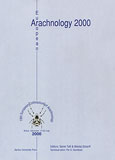 Toft S. & Scharff N. (eds) 2002:
Toft S. & Scharff N. (eds) 2002:
European Arachnology 2000.
Aarhus University Press, Århus, 358 pp. ISBN 87-7934-001-6
Table of contents with separate PDFs
This volume can be bought from www.unipress.dk
– Foreword 5
– Colloquium Photo 8
– Dedication 13-16
PHYSIOLOGY, ECOLOGY, LIFE HISTORY AND BEHAVIOUR
– Seyfarth E.-A., 2002: Tactile body raising: neuronal correlates of a ‘simple’ behavior in spiders. 19–32 (PDF)
– Bartos M., 2002: Distance of approach to prey is adjusted to the prey’s ability to escape in Yllenus arenarius Menge (Araneae, Salticidae). 33–38 (PDF)
– Kürpick S.M., 2002: Cocoon care in the social spider Stegodyphus dumicola (Eresidae). 39–44 (PDF)
– Haupt J., 2002: Fungal and rickettsial infections of some East Asian trapdoor spiders. 45–49 (PDF)
– Baert L. & Maelfait J.P., 2002: The influence of the 1997-1998 El Niño upon the Galápagos lycosid populations, and a possible role in speciation. 51–56 (PDF)
– Sigsgaard L., 2002: Early season natural biological control of insect pests in rice by spiders – and some factors in the management of the cropping system that may affect this control. 57–64 (PDF)
– Nielsen S.A. & Toft S., 2002: Responses of a detoxification enzyme to diet quality in a wolf spider, Pardosa prativaga. 65–70 (PDF)
– Lourenço W.R., 2002: Reproduction in scorpions, with special reference to parthenogenesis. 71–85 (PDF)
– Rouaud C., Huber D. & Lourenço W.R., 2002: Life history of Caribetityus elii (Armas & Marcano Fondeur, 1992) from the Dominican Republic (Scorpiones, Buthidae). 87–90 (PDF)
– Soranzo L., Stockmann R., Lautie N. & Fayet C., 2002: Structure of the ovariuterus of the Scorpion Euscorpius carpathicus (L.) (Euscorpiidae) before fertilization. 91–96 (PDF)
SPIDER WEBS AND SILK
– Zschokke S., 2002: Form and function of the orb-web. 99–106 (PDF)
– Vollrath F., Nørgaard T. & Krieger M., 2002: Radius orientation in the cross spider Araneus diadematus. 107–116 (PDF)
– Benjamin S.P. & Zschokke S., 2002: A computerised method to observe spider web building behaviour in a semi-natural light environment. 117–122 (PDF)
– Kenney J.M., Knight D.P., Dicko C. & Vollrath F., 2002: Linear and circular dichroism can help us to understand the molecular nature of spider silk. 123–126 (PDF)
SEXUAL SELECTION AND SPERM COMPETITION
– Ahtiainen J.J., Alatalo R.V., Kotiaho J.S., Mappes J., Parri S. & Vertainen L., 2002: Sexual selection in the drumming wolf spider Hygrolycosa rubrofaciata. 129–137 (PDF)
– Knoflach B., 2002: Copulation and emasculation in Echinotheridion gibberosum (Kulczynski, 1899) (Araneae, Theridiidae). 139–144 (PDF)
– Uhl G., 2002: Female genital morphology and sperm priority patterns in spiders (Araneae). 145–156 (PDF)
– Berendonck B. & Greven H., 2002: Morphology of female and male genitalia of Latrodectus revivensis Shulov, 1948 (Araneae, Theridiidae) with regard to sperm priority patterns. 157–167 (PDF)
SPIDER COMMUNITIES AND CONSERVATION ECOLOGY
– Canard A. & Ysnel F., 2002: Practical use of a single index to estimate the global range of rarity of spider communities in Western France. 171–176 (PDF)
– De Bakker D., Maelfait J.-P., Desender K., Hendrickx F. & De Vos B., 2002: Regional variation in spider diversity of Flemish forest stands. 177–182 (PDF)
– Moretti M., 2002: Effects of winter fire on spiders. 183–190 (PDF)
– Stánska M., Hajdamowicz I. & Żabka M., 2002: Epigeic spiders of alder swamp forests in Eastern Poland. 191–197 (PDF)
– Pommeresche R., 2002: Spider species and communities in bog and forest habitats in Geitaknottane Nature Reserve, Western Norway. 199–205 (PDF)
– Rėlys V. & Dapkus D., 2002: Similarities between epigeic spider communities in a peatbog and surrounding pine forest: a study from southern Lithuania. 207–214 (PDF)
– Merkens S., 2002: Epigeic spider communities in inland dunes in the lowlands of Northern Germany. 215–222 (PDF)
– Gajdoš P. & Toft S., 2002: Distinctiveness of the epigeic spider communities from dune habitats on the Danish North Sea coast. 223–228 (PDF)
– Wolak M, 2002: The spider fauna of balks. 229–236 (PDF)
– Toft S. & Lövei G.L., 2002: The epigeic spider fauna of single-row hedges in a Danish agricultural landscape. 237–242 (PDF)
– Aakra K, 2002: The riparian spider fauna (Araneae) of the river Gaula, Central Norway: implications for conservation efforts. 243–252 (PDF)
REGIONAL FAUNISTICS
– Mikhailov K.G., 2002: The spider fauna of Russia and other post-Soviet republics: a 2000 update. 255–259 (PDF)
– Mikhailov K.G. & Mikhailova E.A., 2002: Altitudinal and biotopic distribution of the spider family Gnaphosidae in North Ossetia (Caucasus Major). 261–265 (PDF)
– Koponen S., 2002: Spider fauna of peat bogs in southwestern Finland. 267–271 (PDF)
– Rėlys V. & Dapkus D., 2002: Comments to the checklist of Gnaphosidae and Liocranidae (Arachnida, Araneae) of the Baltic States, with remarks on species new to Lithuania. 273–278 (PDF)
– Di Franco F., 2002: Observations on the spider family Gnaphosidae (Araneae) in the nature reserve ‘Oasis of Simeto’ (Italy, Sicily). 279–282 (PDF)
SAMPLING METHODS
– Bell J.R., Wheater C.P., Henderson R. & Cullen W.R., 2002: Testing the efficiency of suction samplers (G-vacs) on spiders: the effect of increasing nozzle size and suction time. 285–290 (PDF)
– Bergthaler G.J. & Rėlys V., 2002: Suction sampling in alpine habitats: experiences and suggestions. 291–297 (PDF)
– Tóth F., 2002: An improved version of the ‘aspirator gun’ – a device for collecting arthropods. 299–300 (PDF)
TAXONOMY, SYSTEMATICS AND EVOLUTION
– Kraus O., 2002: Why no subspecies in spiders? 303–314 (PDF)
– Lehtinen P.T., 2002: Generic revision of some thomisids related to Xysticus C.L.Koch, 1835 and Ozyptila Simon, 1864. 315–327 (PDF)
– Jantscher E., 2002: The significance of male pedipalpal characters for the higher systematics of the crab spider genus Xysticus C.L. Koch, 1835 (Araneae: Thomisidae). 329–336 (PDF)
– Thaler K. & Knoflach B., 2002: A superspecies in the genus Amaurobius on Crete, and additional records from Greece (Araneae: Amaurobiidae). 337–344 (PDF)
– Dunlop J.A., 2002: Character states and evolution of the chelicerate claws. 345–354 (PDF)
– Wunderlich J., 2002: Ant mimicry by spiders and spider-mite interactions preserved in Baltic amber (Arachnida: Acari, Araneae). 355–358 (PDF)
18. ESA, Stará Lesná, Slovakia 1999
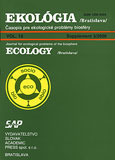 Gajdoš P., Pekár S. & Sunderland K. (eds) 2000:
Gajdoš P., Pekár S. & Sunderland K. (eds) 2000:
Proceedings of the 18th European Colloquium of Arachnology.
Ekológia (Bratislava) 19, Suppl. 3: 1–318. ISSN 1335-342X
Table of contents with separate PDFs
– Pekar S., 2000: Introduction. (PDF)
– Bilde T. & Toft S., 2000: Evaluation of prey for the spider Dicymbium brevisetosum Locket (Araneae: Linyphiidae) in single-species and mixed-species diets. Ekológia (Bratislava) 19, Suppl. 3: 9–18 (PDF)
– Cardoso P., 2000: Portuguese spiders (Araneae): a preliminary checklist. Ekológia (Bratislava) 19, Suppl. 3: 19–29 (PDF)
– Cardoso P., 2000: Description of the supposed male Nemesia hispanica L. Koch in Ausserer, 1871 (Araneae: Nemesiidae). Ekológia (Bratislava) 19, Suppl. 3: 31–36 (PDF)
– Danilov S.N., 2000: New data on the spiders of the family Dictynidae (Araneae) from Siberia. Ekológia (Bratislava) 19, Suppl. 3: 37–44 (PDF)
– De Bakker D., Maelfait J.-P., Hendrickx F., Van Waesberghe D., De Vos B., Thys S.& De Bruyn L., 2000: A first analysis on the relationship between forest soil quality and spider (Araneae) communities of Flemish forest stands. Ekológia (Bratislava) 19, Suppl. 3: 45–58 (PDF)
– Deltshev C., 2000: The endemic spiders (Araneae) of the Balkan peninsula. Ekológia (Bratislava) 19, Suppl. 3: 59–65 (PDF)
– Dunlop J.A., 2000: The epistomo-labral plate and lateral lips in solifuges, pseudoscorpions and mites. Ekológia (Bratislava) 19, Suppl. 3: 67–78 (PDF)
– Gromov A.V., 2000: Solpugids of the genus Eusimonia Kraepelin, 1899 (Arachnida: Solifugae, Karschiidae) of Central Asia. Ekológia (Bratislava) 19, Suppl. 3: 79–86 (PDF)
– Gurdebeke S., Neirynck B. & Maelfait J.-P., 2000: Population genetic effects of forest fragmentation in Flanders (Belgium) on Coelotes terrestris (Araneae: Agelenidae) as revealed by allozymes and RAPD. Ekológia (Bratislava) 19, Suppl. 3: 87–96 (PDF)
– Heiling A.M. & Herberstein M.E., 2000: Interpretations of orb-web variability: a review of past and current ideas. Ekológia (Bratislava) 19, Suppl. 3: 97–106 (PDF)
– Junker E.A., Ratschker U.M. & Roth M., 2000: Impacts of silvicultural practice on the ground living-spider community (Arachnida: Araneae) of mixed mountain forests in the Chiemgau Alps (Germany). Ekológia (Bratislava) 19, Suppl. 3: 107–117 (PDF)
– Kasal P., Hladíková M. & Hänggi A., 2000: Prediction of spider species occurrence: an example using theridiid spiders (Araneae). Ekológia (Bratislava) 19, Suppl. 3: 119–123 (PDF)
– Klimeš L., 2000: Checklist of harvestmen (Opiliones) of Czechia and Slovakia. Ekológia (Bratislava) 19, Suppl. 3: 125–128 (PDF)
– Kovoor J. & Muñoz-Cuevas A., 2000: Comparative histology of the venom glands in a lycosid and several oxyopid spiders (Araneae). Ekológia (Bratislava) 19, Suppl. 3: 129–140 (PDF)
– Lourenço W.R., Huber D. & Cloudsley-Thompson J.L., 2000: Description of the stridulatory apparatus in some species of the genus Rhopalurus Thorell (Scorpiones: Buthidae). Ekológia (Bratislava) 19, Suppl. 3: 141–144 (PDF)
– Lourenço W.R. & Monod L., 2000: Description of a new genus and species of scorpion (Bothriuridae) from Brazil. Ekológia (Bratislava) 19, Suppl. 3: 145–152 (PDF)
– Mayntz D. & Toft S., 2000: Effect of nutrient balance on tolerance to low quality prey in a wolf spider (Araneae: Lycosidae). Ekológia (Bratislava) 19, Suppl. 3: 153–158 (PDF)
– Mitov P., 2000: Contribution to the knowledge of the harvestmen (Arachnida: Opiliones) of Albania. Ekológia (Bratislava) 19, Suppl. 3: 159–170 (PDF)
– Muñoz-Cuevas A. & Carricaburu P., 2000: Electroretinographic modulation by dopamine and noradrenaline in the spider Lycosa tarentula (Araneae: Lycosidae). Ekológia (Bratislava) 19, Suppl. 3: 171–180 (PDF)
– Muster C., 2000: Arachnological evidence for glacial refugia in the Bavarian Alps. Ekológia (Bratislava) 19, Suppl. 3: 181–192 (PDF)
– Nobre T. & Meierrose C., 2000: The species composition, within-plant distribution, and possible predatory role of spiders (Araneae) in a vineyard in Southern Portugal. Ekológia (Bratislava) 19, Suppl. 3: 193–200 (PDF)
– Nobre T., Meierrose C. & Gaspar De Oliveira N., 2000: Comparison of sampling techniques for vineyard foliage spiders (Araneae). Ekológia (Bratislava) 19, Suppl. 3: 201–206 (PDF)
– Petrova V., Čudare Z. & Šteiníte I., 2000: Seasonal dynamics of predatory mites (Acari: Phytoseiidae) on strawberries in Latvia. Ekológia (Bratislava) 19, Suppl. 3: 207–210 (PDF)
– Petrova V. & Salmane I., 2000: Some mite (Acari) species from mass-rearing laboratories of commercial mushrooms and beneficial arthropods in Latvia. Ekológia (Bratislava) 19, Suppl. 3: 211–212 (PDF)
– Ratschker U.M. & Roth M., 2000: Studies on ground dwelling spiders (Araneae) of agrarian habitat types in Northeast Germany: ecological and nature conservation aspects. Ekológia (Bratislava) 19, Suppl. 3: 213–225 (PDF)
– Relys V., 2000: Arctic-alpine and boreo-montane spider species (Araneae) in epigeic spider communities in the subalpine zone of the Eastern Alps. Ekológia (Bratislava) 19, Suppl. 3: 227–234 (PDF)
– Růžička V., 2000: Spiders (Araneae) of two valleys in the Krkonoše Mts. (Czech Republic). Ekológia (Bratislava) 19, Suppl. 3: 235–244 (PDF)
– Salmane I., 2000: Investigation of the seasonal dynamics of soil Gamasina mites (Acari: Mesostigmata) in Pinaceum myrtilosum, Latvia. Ekológia (Bratislava) 19, Suppl. 3: 245–252 (PDF)
– Scherabon B., Gantenbein B., Fet V., Barker M., Kuntner M., Kropf C. & Huber D., 2000: A new species of scorpion from Austria, Italy, Slovenia and Croatia: Euscorpius gamma Caporiacco, 1950, stat. nov. (Scorpiones: Euscorpiidae). Ekológia (Bratislava) 19, Suppl. 3: 253–262 (PDF)
– Snazell R. & Clarke R., 2000: The colonisation of an area of restored chalk downland by spiders (Araneae). Ekológia (Bratislava) 19, Suppl. 3: 263–271 (PDF)
– Toft S., 2000: Species and age effects in the value of cereal aphids as food for a spider (Araneae). Ekológia (Bratislava) 19, Suppl. 3: 273–278 (PDF)
– Tóth F., 2000: Aspirator gun – a new device for sampling spiders and insects. Ekológia (Bratislava) 19, Suppl. 3: 279–280 (PDF)
– Walter J.E., 2000: A look at arachnology in the 18th century. Ekológia (Bratislava) 19, Suppl. 3: 281–282 (PDF)
– Wilczek G. & Babczyńska A., 2000: Heavy metals in the gonads and hepatopancreas of spiders (Araneae) from variously polluted areas. Ekológia (Bratislava) 19, Suppl. 3: 283–292 (PDF)
– Żabka M. & Nentwig W., 2000: Salticidae (Arachnida: Araneae) of the Krakatau Islands (Indonesia) – a preliminary approach. Ekológia (Bratislava) 19, Suppl. 3: 293–306 (PDF)
– Zschokke S. & Vollrath F., 2000: Planarity and size of orb-webs built by Araneus diadematus (Araneae: Araneidae) under natural and experimental conditions. Ekológia (Bratislava) 19, Suppl. 3: 307–318 (PDF)
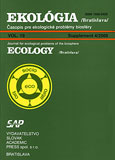 Gajdoš P., Pekár S. & Sunderland K. (eds) 2000:
Gajdoš P., Pekár S. & Sunderland K. (eds) 2000:
Proceedings of the 18th European Colloquium of Arachnology. Workshop “Biodiversity and conservation of arachnids of wetlands habitats”.
Ekológia (Bratislava) 19, Suppl. 4: 1–110. ISSN 1335-342X
Table of contents with separate PDFs
Table of contents
– Bonte D., Maelfait J.-P. & Hoffmann M., 2000: Seasonal and diurnal migration patterns of the spider (Araneae) fauna of coastal grey dunes. Ekológia (Bratislava) 19, Suppl. 4: 5–16 (PDF)
– Di Franco F. & Lovetere F., 2000: Preliminary results on the arachnofauna (Araneae) of the Nature Reserve “Oasis of Simeto”. Ekológia (Bratislava) 19, Suppl. 4: 17–22 (PDF)
– Franc V., 2000: Spiders (Araneae) on the Red Lists of European countries. Ekológia (Bratislava) 19, Suppl. 4: 23–28 (PDF)
– Gajdoš P. & Toft S., 2000: Changes in the spider (Araneae) fauna along a heathland-marsh transect in Denmark. Ekológia (Bratislava) 19, Suppl. 4: 29–38 (PDF)
– Gravesen E., 2000: Spiders (Araneae) and other invertebrate groups as ecological indicators in wetland areas. Ekológia (Bratislava) 19, Suppl. 4: 39–42 (PDF)
– van Helsdingen P.J., 2000: Spider (Araneae) protection measures and the required level of knowledge. Ekológia (Bratislava) 19, Suppl. 4: 43–50 (PDF)
– Holec M., 2000: Spiders (Araneae) of the fishpond eulittoral zone. Ekológia (Bratislava) 19, Suppl. 4: 51–54 (PDF)
– Kajak A., Kupryjanowicz J. & Petrov P., 2000: Long term changes in spider (Araneae) communities in natural and drained fens in the Biebrza River Valley. Ekológia (Bratislava) 19, Suppl. 4: 55–64 (PDF)
– Komposch C., 2000: Harvestmen and spiders in the Austrian wetland “Hörfeld-Moor” (Arachnida: Opiliones, Araneae). Ekológia (Bratislava) 19, Suppl. 4: 65–77 (PDF)
– Koponen S., 2000: Spiders (Araneae) on sandy islands in the southwestern archipelago of Finland. Ekológia (Bratislava) 19, Suppl. 4: 79–85 (PDF)
– Salmane I., 2000: Fauna of soil-dwelling predatory Gamasina mites (Acari: Mesostigmata) in seashore habitats of the Kurzeme Coast, Latvia. Ekológia (Bratislava) 19, Suppl. 4: 87–96 (PDF)
– Svatoň J. & Prídavka R., 2000: Spiders (Araneae) of the peatbog National Nature Reserve Švihrovské rašelinisko (Slovakia). Ekológia (Bratislava) 19, Suppl. 4: 97–104 (PDF)
– Szinetár C., 2000: – Data on the biology of Larinia jeskovi Marusik, 1986 (Araneae: Araneidae) from the reed belts of Lake Balaton. Ekológia (Bratislava) 19, Suppl. 4: 105–110 (PDF)
17. ESA, Edinburgh, Scotland 1997
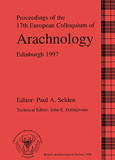 Selden P.A. (ed) 1998:
Selden P.A. (ed) 1998:
Proceedings of the 17th European Colloquium of Arachnology.
British Arachnological Society, Burnham Beeches, Bucks, 350 pp.
ISBN 0-9500093-2-6
Table of contents with separate PDFs
Purchase: http://www.britishspiders.org.uk/html/bas.php?page=cq&menu=publ
– Preface and contents (PDF)
– Author Index (PDF)
– Kraus O., 1998: Elucidating the historical process of phylogeny: Phylogenetic Systematics versus cladistic techniques. 1–7 (PDF)
– Dunlop J.A., 1998: The origins of tetrapulmonate book lungs and their significance for chelicerate phylogeny. 9–16 (PDF)
– Jeram A.J., 1998: Phylogeny, classification and evolution of Silurian and Devonian scorpions. 17–31 (PDF)
– Gantenbein B., Büchi L., Braunwalder M.E. & Scholl A., 1998: The genetic population structure of Euscorpius germanus (C. L. Koch) (Scorpiones: Chactidae) in Switzerland. 33–40 (PDF)
– Gillespie R.G., Rivera M.A.J. & Garb J.E., 1998: Sun, surf and spiders: taxonomy and phylogeography of Hawaiian Araneae. 41–51 (PDF)
– Jäger P., 1998: First results of a taxonomic revision of the SE Asian Sparassidae (Araneae). 53–59 (PDF)
– Baehr B., 1998: The genus Hersilia: phylogeny and distribution in Australia and New Guinea (Arachnida, Araneae, Hersiliidae). 61–65 (PDF)
– Todd Davies V., 1998: A redescription and renaming of the Tasmanian spider Amphinecta milvina (Simon, 1903), with descriptions of four new species (Araneae: Amaurobioidea: Amaurobiidae). 67–82 (PDF)
– Main B.Y., 1998: Hogg’s phantom spider from Central Australia: a century-old mystery solved. 83–90 (PDF)
– Milasowszky N., Herberstein M.E. & Zulka K.P., 1998: Morphological separation of Trochosa robusta (Simon, 1876) and Trochosa ruricola (De Geer, 1778) females (Araneae: Lycosidae). 91–96 (PDF)
– El-Hennawy H.K., 1998: Redescription of the male of Dorceus quadrispilotus Simon, 1908 from Egypt (Araneae: Eresidae). 97–100 (PDF)
– Růžička V., 1998: The subterranean forms of Lepthyphantes improbulus, Theonoe minutissima and Theridion bellicosum (Araneae: Linyphiidae, Theridiidae). 101–105 (PDF)
– Thaler K. & Knoflach B., 1998: Two new species and new records of the genus Amaurobius (Araneae, Amaurobiidae) from Greece. 107–114 (PDF)
– Żabka M. & Prószyńsky J., 1998: Middle European Euophrys C. L. Koch, 1834 (Araneae: Salticidae) — one, two or three genera? 115–120 (PDF)
– Oxford G.S., 1998: Guanine as a colorant in spiders: development, genetics, phylogenetics and ecology. 121–131 (PDF)
– Kovoor J. & Muñoz-Cuevas A., 1998: Structure and function of the silk-gland system in Oxyopidae (Araneae). 133–141 (PDF)
– Muñoz-Cuevas A., Carricaburu P. & Kovoor J., 1998: Comparative electroretinography of Peucetia gerhardi and Peucetia graminea (Araneae: Oxyopidae). 143–150 (PDF)
– Kropf C., 1998: Slit sense organs of Comaroma simonii Bertkau: a morphological atlas (Araneae, Anapidae). 151–159 (PDF)
– Vollrath F., 1998: Sex-linked differences in the growth of Nephila clavipes. 161–166 (PDF)
– Yoward P.J., 1998: Sperm competition in Pholcus phalangioides (Fuesslin, 1775) (Araneae, Pholcidae) — shorter second copulations gain a higher paternity reward than first copulations. 167–170 (PDF)
– Bartos M., 1998: Quantitative analyses of male courtship behaviour in Pholcus phalangioides (Fuesslin, 1775) (Araneae, Pholcidae). 171–176 (PDF)
– Blandenier G. & Fürst P.-A., 1998: Ballooning spiders caught by a suction trap in an agricultural landscape in Switzerland. 177–186 (PDF)
– Duffey E., 1998: Aerial dispersal in spiders. 187–191 (PDF)
– Pasquet A. & Leborgne R., 1998: Management of web construction in different spider species. 193–196 (PDF)
– Herberstein M.E., 1998: Implications of microhabitat selection on prey capture for the web spider Neriene radiata (Walckenaer) (Araneae: Linyphiidae). 197–202 (PDF)
– Riechert S.E: & Maupin J.L., 1998: Spider effects on prey: tests for superfluous killing in five web-builders. 203–210 (PDF)
– Heiling A.M. & Herberstein M.E., 1998: Activity patterns in different developmental stages and sexes of Larinioides sclopetarius (Clerck) (Araneae, Araneidae). 211–214 (PDF)
– Samu F., Németh J., Tóth F., Szita E., Kiss B. & Szinetár C., 1998: Are two cohorts responsible for the bimodal life-history pattern in the wolf spider Pardosa agrestis in Hungary? 215–221 (PDF)
– Koomen P., 1998: Winter activity of Anyphaena accentuata (Walckenaer, 1802) (Araneae: Anyphaenidae). 223–225 (PDF)
– Framenau V., 1998: Life cycles of Lycosa lapidosa McKay, 1974, and Lycosa arenaris (Hogg, 1905), two riparian wolf spiders from south-eastern Australia. 227–234 (PDF)
– Chatzaki M., Trichas A., Markakis G. & Mylonas M., 1998: Seasonal activity of the ground spider fauna in a Mediterranean ecosystem (Mt Youchtas, Crete, Greece). 235–243 (PDF)
– Szymkowiak P. & Woźny M., 1998: Dominance structure and seasonal changes in the abundance of dominant epigeic spiders in pastures of northern Greater Poland. 245–252 (PDF)
– Bell J.R., Cullen W.R. & Wheater C.P., 1998: The structure of spider communities in limestone quarry environments. 253–259 (PDF)
– Bell J.R., Haughton A.J., Cullen W.R. & Wheater C.P., 1998: The zonation and ecology of a sand-dune spider community. 261–266 (PDF)
– Kupryjanowicz J., Hajdamowicz I., Stankiewicz A. & Staręga W., 1998: Spiders of some raised peat bogs in Poland. 267–272 (PDF)
– Jonsson L.J., 1998: Spiders of the Skäralid Gorge, southernmost Sweden. 273–276 (PDF)
– Lisken-Kleinmans A., 1998: The spider community of a northern German heathland: faunistic results. 277–284 (PDF)
– Hendrickx F., Maelfait J.-P., Muylaert W. & Hoffmann M., 1998: Spider distribution patterns along the tidal River Scheldt (Belgium). 285–291 (PDF)
– Maelfait J.-P. & Hendrickx F., 1998: Spiders as bio-indicators of anthropogenic stress in natural and semi-natural habitats in Flanders (Belgium): some recent developments. 293–299 (PDF)
– Riecken U., 1998: The importance of semi-natural landscape structures in an agricultural landscape as habitats for stenotopic spiders. 301–310 (PDF)
– Downie I.S., Abernethy V.J, Foster G.N., McCracken D.I., Ribera I. & Waterhouse A., 1998: Spider biodiversity on Scottish agricultural land. 311–317 (PDF)
– Canard A., Marc P. & Ysnel F., 1998: Comparative value of habitat biodiversity: an experimental system based on spider community analysis. 319–323 (PDF)
– Churchill T.B., 1998: Spiders as ecological indicators in the Australian tropics: family distribution patterns along rainfall and grazing gradients. 325–330 (PDF)
– Zulka K.P. & Milasowszky N., 1998: Conservation problems in the Neusiedler See–Seewinkel National Park, Austria: an arachnological perspective. 331–336 (PDF)
– Pekár S., 1998: Effect of selective insecticides on the beneficial spider community of a pear orchard in the Czech Republic. 337–342 (PDF)
– Noordam A.P., Samson R.A. & Sudhaus W., 1998: Fungi and Nematoda on Centromerus sylvaticus (Araneae, Linyphiidae). 343–347 (PDF)
16. ESA, Siedlce, Poland 1996
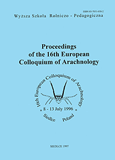 Zabka M. (ed) 1997:
Zabka M. (ed) 1997:
Proceedings of the 16th European Colloquium of Arachnology.
Wyzsza Szkola Rolnicko-Pedagogiczna, Siedlce, 334 pp. ISBN 83-7051-0858-2
Table of contents with separate PDFs
Purchase: Marek Zabka, Katedra Zoologii AP 08-110 Siedlce, Poland. e-mail: zabka(a)ap.siedlce.pl
– Baert L. & Maelfait J.-P., 1997: Distribution and ecology of the lycosid spiders occurring on the Santa Cruz island, Galapagos Archipelago, Ecuador. 1–11 (PDF)
– Barthel J., 1997: Habitat preferences of Enoplognatha latimana Hippa et Oksala, 1982, and Enoplognatha ovata (Clerck, 1757) (Araneae: Theridiidae) in agricultural landscapes in Southern Bavaria (Germany). 13–25 (PDF)
– Bartos M., 1997: Development of male pedipalps prior to the final moulting in Pholcus phalangioides (Fuesslin) (Araneae, Pholcidae). 27–35 (PDF)
– Baumann T., 1997: Habitat selection and dispersal power of the spider Eresus cinnaberinus (Olivier, 1789) in the porphyry landscape near Halle (Saale). 37–45 (PDF)
– Bergthaler G.J., 1997: Unusual epigynes of Pardosa (Araneae: Lycosidae) – aberration, hybridisation or new species? 47–49 (PDF)
– von Broen B., 1997: Insufficient knowledge of so-called ‘rare’ spiders in Germany – a brief comment. 51–55 (PDF)
– Buchar J., 1997: Supplement to the check list of spiders of the Czech Republic. 57–63 (PDF)
– Dunlop J.A:, 1997: Palaeozoic arachnids and their significance for arachnid phylogeny. 65–82 (PDF)
– Finch O.-D., 1997: Spider wasps (Hymenoptera, Pompilidae) as predators of a spider taxocoenosis. 83–89 (PDF)
– Gajdoš P. & Krištin A., 1997: Spiders (Araneae) as bird food. 91–105 (PDF)
– Haupt J., 1997: A self-made taxonomic character in whip scorpions (Arachnida, Uropygi: Thelyphonida). 107–111 (PDF)
– van Helsdingen P.J., 1997: Floodplain spider communities. 113–126 (PDF)
– Jędryczkowski W.B., 1997: Ecological factors in the distribution of Carpathian elements in Poland. 127–131 (PDF)
– Kasal P., 1997: Evolution of tarsal comb in theridiid spiders (Arachnida: Araneae). 133–137 (PDF)
– Komposch C., 1997: The arachnid fauna of different stages of succession in the Schütt rockslip area, Dobratsch, southern Austria (Arachnida: Scorpiones, Opiliones, Araneae). 139–149 (PDF)
– Kropf C., 1997: Egg sac structure and further biological observations in Comaroma simonii Bertkau (Araneae, Anapidae). 151–164 (PDF)
– Kuntner M., 1997: A contribution to the knowledge of the Slovenian spider fauna: eleven species new for Slovenia and some other interesting findings (Arachnida, Araneae). 165–172 (PDF)
– Kuntner M. & Baxter I.H., 1997: Preliminary investigation of spider species richness in an eastern Slovenian broadleaf forest. 173–182 (PDF)
– Kupryjanowicz J., 1997: Spiders of the Biebrza National Park – species new and rare to Poland. 183–194 (PDF)
– Logunov D.V., 1997: Vicariance in the northern Asian Salticidae (Arachnida, Araneae), with notes on Siberian endemism of the family. 195–209 (PDF)
– Łuczak J., 1997: Ecotonal systems on the border of the Kampinos Forest and their importance to spiders. 211–219 (PDF)
– Maelfait J.-P., Baert L. & Desender K., 1997: Effects of groundwater catchment and grassland management on the spider fauna of the dune nature reserve ‘De Westhoek’ (Belgium). 221–236 (PDF)
– Merkens S., 1997: Influence of environmental factors on the community structure of spiders in a humidity gradient of extensively managed, moist pastures. 237–248 (PDF)
– Mitov P., 1997: Preliminary investigations on the spatial distribution of the harvestmen (Opiliones, Arachnida) from Vitosha Mt. (SW Bulgaria). 249–258 (PDF)
– Niedbała W., 1997: Ptyctimous mites (Acari, Oribatida) of the Pacific Islands. 259–260 (PDF)
– Petrov B.P., 1997: A Review of Bulgarian pseudoscorpions (Araclmida, Pseudoscorpionida). 261–269 (PDF)
– Rakov S.Y. & Logunov D.V., 1997: Taxonomic notes on the genus Menemerus Simon, 1868 in the fauna of Middle Asia (Araneae, Salticidae). 271–279 (PDF)
– Růžička V., 1997: Spiders (Araneae) of dwarf Norway spruces. 281–287 (PDF)
– Schmidt G., 1997: Families and genera of Cape Verdean spiders in comparison to those of the Canary Islands. 289–293 (PDF)
– Szymkowiak P., 1997: Brommella falcigera (Balogh, 1935), a rare European spider. 295–299 (PDF)
– Toft S. & Nielsen S.A., 1997: Influence of diet quality on the respiratory metabolism of a wolf spider Pardosa prativaga. 301–307 (PDF)
– Tóth F. & Kiss J., 1997: Occurrence of Pardosa (Araneae, Lycosidae) species in winter wheat and in the field margin. 309–315 (PDF)
– Wilczek G., Majkus Z., Migula P., Bednarska K. & Świerczek E., 1997: Heavy metals and detoxifying enzymes in spiders from coal and metallurgic dumps near Ostrava (Czech Republic). 317–328 (PDF)
– Samuel Zschokke S., 1997: Factors influencing the size of the orb web in Araneus diadematus. 329–334 (PDF)
15. ESA, České Budějovice, Czech Republic 1994
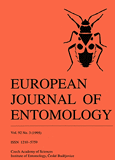 European Journal of Entomology 92 (3): 523–608
European Journal of Entomology 92 (3): 523–608
České Budějovice 1995. ISSN 1210-5759
Table of contents with separate PDFs
Purchase: Institute of Entomology, Czech Academy of Sciences, Branišovská 31, 370 05 České Budějovice, Czech Republic.
– Zschokke S. & Vollrath F., 1995: Web construction in a range of orb-weaving spiders (Araneae). European Journal of Entomology 92 (3): 523–541 (PDF)
– Sláma K., 1995: Respiratory cycles of Chelifer cancroides (Pseudoscorpiones) and Galeodes sp. (Solifugae). European Journal of Entomology 92 (3): 543–552 (PDF)
– Schütt K., 1995: Drapetisca socialis (Araneae: Linyphiidae): Web reduction – ethological and morphological adaptations. European Journal of Entomology 92 (3): 553–563 (PDF)
– Kovoor J. & Muñoz-Cuevas A., 1995: Embryonic and postembryonic morphogenesis of the visual, venom- and silk-gland systems in two species of Peucetia (Araneae: Oxyopidae). European Journal of Entomology 92 (3): 565–571 (PDF)
– Kajak A., 1995: The role of soil predators in decomposition processes. European Journal of Entomology 92 (3): 573–580 (PDF)
– Deltshev C., 1995: A review of the family Agelenidae (Araneae) in Bulgaria. Taxonomic, faunistic and zoogeographical analysis. European Journal of Entomology 92 (3): 581–588 (PDF)
– Logunov D.V., 1995: The genus Mogrus (Araneae: Salticidae) of Central Asia. European Journal of Entomology 92 (3): 589–604 (PDF)
– Haupt J., 1995: Twig-lining in a trapdoor spider Latouchia swinhoei from Okinawa. European Journal of Entomology 92 (3): 605–608 (PDF)
Proceedings of the 15th European Colloquium of Arachnology (1994).
Institute of Entomology, Czech Academy of Sciences, České Budějovice, 238 pp. ISBN 90-901250-1-8
Table of contents with separate PDFs
– Preface. 3–8 (PDF)
– Barthel J. & Plachter H., 1995: Distribution of foliage-dwelling spiders in uncultivated areas of agricultural landscapes (Southern Bavaria, Germany) (Arachnida, Araneae). 11–21 (PDF)
– Bergthaler G.J., 1995: The cocoon of Argiope bruennichi (Scopoli, 1772)—a SEM-study. 22–26 (PDF)
– Bonaric J.-C., 1995: Le système neuroendocrine rétrocérébral des Araignées: structure et fonction. 27–34 (PDF)
– Buchar J., Růžička V. & Kůrka A., 1995: Check list of spiders of the Czech Republic. 35–53 (PDF)
– Duffey E., 1995: The distribution, status and habitats of Dolomedes fimbriatus (Clerck) and D. plantarius (Clerck) in Europe. 54–65 (PDF)
– Follner K. & Klarenberg A.J., 1995:– Aeronautic Behaviour in the Wasp-like Spider, Argiope bruennichi (Scopoli) (Araneae, Argiopidae). 66–72 (PDF)
– Gajdoš P., 1995: The epigeic spider communities of lowland forests in the surrounings of the Danube River on the territory of Slovakia and their usage for biota monitoring. 73–83 (PDF)
– Hajer J., 1995: Notes on spinning activity and the way of life of the spiders Cyrtophora citricola, Argyrodes gibbosus and Holocnemus pluchei. 84–88 (PDF)
– van Helsdingen P.J., 1995: The spider fauna of Ireland. 89–92 (PDF)
– Holl A., Lux M. & Holl A., 1995: Life cycle and adaptative colouration in Micromata virescens (Clerck, 1757) (Heteropodidae). 93–98 (PDF)
– Kasal P., Chvátalová I. & Zbytek F., 1995: Method for graphic representation of ecological types of spiders. 99–102 (PDF)
– Kasal P., Chvátalová I. & Zbytek F., 1995: Relations between chaeototaxis and ecological type of Linyphiid spiders. 103–106 (PDF)
– Lang A., Filser J., Mommertz S. & Gigglinger S., 1995: Relationships between lycosid spiders and their prey in an agroecosystem. An outline of a project. 107–110 (PDF)
– Lang A. & Klarenberg A.J., 1995:– A note on body size parameters and some life history data of Pisaura mirabilis (Avaneae, Pisauridae). 111–115 (PDF)
– Łuczak J. & Dąbrowska-Prot E., 1995: Araneae communities and the functioning of prey—predator system (dipterans—spiders) in the devastated Karkonosze Mountain forest. 116–124 (PDF)
– Maelfait J.-P., De Knijf G., De Becker P. & Huybrechts W., 1995: Analysis of the spider fauna of the riverine forest nature reserve ‘Walenbos’ (Flanders, Belgium) in relation to hydrology and vegetation. 125–135 (PDF)
– Malt S., 1995: Epigeic spiders as an indicator system to evaluate biotope quality of riversides and floodplain grasslands on the river Ilm (Thuringia). 136–146 (PDF)
– Mitov P., 1995: Teratological data about Opiliones (Arachnida) from Bulgaria. 147–158 (PDF)
– Relys V., 1995: Arachnologische Forschungen in Litauen: kurze historische Übersicht. 159–161 (PDF)
– Shavanova T., 1995: The spider fauiia (Arachnida: Aranei) in various types of pine forests in the Berezinski State Biosphere Reserve, Belarus. 162–168 (PDF)
– Šternbergs M., 1995: The spiders (Aranei) in the litter of Fraxinetum dryopterioso forest type in the Slitere Nature Reserve. 169–173 (PDF)
– Vlček K., 1995: The wolf spider Pardosa alacris (Araneae, Lycosidae): the courtship display of this and related species and pheromone communication. 174–183 (PDF)
– Weiss I., 1995: Spinnen und Weberknechte auf Baumstämmen im National Park Bayerischer Wald. 184–192 (PDF)
– Wunderlich J., 1995: On the biogeography of some so-called gondwanaland-spiders—new findings after investigation of fossil spiders (Araneae) in amber. 193–194 (PDF)
– Żabka M., 1995: Remarks on evolution of Salticidae (Arachnida: Araneae). 195–201 (PDF)
ABSTRACTS
– Alicata P. & Cantarella T., 1995: Remarks on the chorology of the Sicilian Salticidae. 205 (PDF)
– Arnedo M.-A. & Ribera C., 1995: Adaptative radiation of the genus Dysdera (Araneae, Haplogynae) in the Canary Islands. An small scale example: La Gomera. 206 (PDF)
– Blick T., 1995: Initial spider succession at managed forest borders. 207 (PDF)
– Bögeman U. & Haupt J., 1995: Molecular genetic analysis of some mesothel spiders (Heptathelidae). 208 (PDF)
– Bonaric J.C. & Emerit M., 1995: Complementary datas on behalf of the unity of labidognath spiders neuroendocrin system. 209 (PDF)
– Buchar J., 1995: Zoogeographical questions of Czech spiders. 210 (PDF)
– Colmorgen M. & Paul R.J., 1995: Structure and function of the open circulatory system of spiders—a study applying histochemical and optophysiological methods. 211 (PDF)
– Cordes D., 1995: Pardosa amentata (Clerck), a well known wolf spider?. 212 (PDF)
– Cordes D., 1995: Alopecosa accentuata and A. barbipes (Araneae, Lycosidae) in Central and Northern Europe. 213 (PDF)
– Cordes D., 1995: A new Alopecosa-species found in Greece. 214 (PDF)
– Ćurčić B.P.M., Ćurčić N.B., Makarov S.E. & Dimitrijević R.N., 1995: Pedal anomalies in Neobisium carpaticum Beier and Roncus pannonius Ćurčić, Dimitrijević & Karamata (Neobisiidae, Pseudoscorpiones), from Yugoslavia. 215 (PDF)
– Ćurčić B.P.M., Legg G. & Dimitrijević R.N., 1995: Malformations in pseudoscorpions. 216 (PDF)
– Danilov S.N., 1995: New data on the spider genus Micaria Westr. from Siberia, with a description of a new species. 217 (PDF)
– Gajdoš P. & loboda K., 1995: Utilizing of data spider occurence in Slovakia in the field of landscape ecology. 218 (PDF)
– Giribet G., Caranza S. & Ribera C., 1995: Molecular phylogeny of Opiliones based on 18S rDNA sequences 219 (PDF)
– Henschel J.R. & Lubin Y.D., 1995: Foraging behaviour of the namib dune spider Seothyra (Eresidae) in relation to prey availability. 220 (PDF)
– Huber B.A., 1995: Function and evolution of spider genitalic structures, examplified by the cheliceral apophyses in Pholcidae and the retrolateral tibial apophysis in the rta-clade. 221 (PDF)
– Huber B.A., 1995: Reroductive biology and functional morphology of the copulatory organs in Psilochorus simoni (Berland, 1911) (Araneae, Pholcidae). 222 (PDF)
– Jonsson L.J., 1995: On the spider species of Theridiidae in Sweden. 223 (PDF)
– Král J., 1995: The karyotype studies in central Europe’s species of the superfamilies Amaurobioidea and Dictynoidea (Araneida). 224 (PDF)
– Kraus O., 1995: The importance of functional morphology for the reconstruction of phylogenetic relationships. 225 (PDF)
– Kůrka A., 1995: Wolf spiders (Lycosidae) in the peatbogs of the Czech Republic. 226 (PDF)
– Marusik Y.M., 1995: Fauna and populations of stone debris spiders of Beringia (Northeast Siberia and Northwest America). 227 (PDF)
– Marusik Y.M., Bartosh O.P. & Gorbunova Y.V., 1995: Taxonomy and zoogeography of lycosid spiders from Northeast Asia (Araneae, Lycosidae). 228 (PDF)
– Relys V., 1995: Species composition of spiders from Alnetum in Hohe Tauern (East Alps) in comparison with material from some other similar habitats in Europe. 229 (PDF)
– Relys V., 1995: Some rare and zoogeographical remarkable spider species from Lithuania. 230 (PDF)
– Schmidt G., 1995: Studies on Australian Selenocosmia species. 231 (PDF)
– Schwendinger P.J., 1995: Idiops pylorus (Idiopidae), a remarkable trap-door spider from Thailand. 232 (PDF)
– Simon U., 1995: Vertical habitat and horizontal isolation of tree living spiders. 233 (PDF)
– Šmaha J., 1995: Comparison of epigeic arachnofauna of most frequent biotopes and permanent plant associations in Czech hilly country based on the optimum biotope analysis. 234 (PDF)
– Thaler K., 1995: Distribution patterns of Lepthyphantes species of the Alps (Linyphiidae). 235 (PDF)
– Villepoux O., 1995: A spider from genus Trebacosa (Lycosidae). 236 (PDF)
– Zyuzin A.A., Tarabaev C.K. & Fyodorov A.A., 1995: Spider fauna in different types of Kazakhstan deserts. 237 (PDF)
– Zyuzin A.A., Tarabaev C.K. & Fyodorov A.A., 1995: Spiders from arid habitats of southeastern Kazakhstan. 238 (PDF)
14. ESA, Catania, Italy, 1993
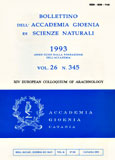 Cantarella T., Alicata P. & Marcellino I. (eds) 1994:
Cantarella T., Alicata P. & Marcellino I. (eds) 1994:
XIV European Colloquium of Arachnology.
Bolletino dell’Accademia Gioenia di Scienze Naturali, Catania 26 (345).
Table of contents with separate PDFs
– Preface (PDF)
– Baert L., 1994: Spider communities of Belgian coniferous stands. 5–13 (PDF)
– Orta J.M., Moya J. & Barrientos J.A., 1994: Datos fenolológicos de una poblaciòn de Lycosa tarentula fasciiventris L. Dufour, 1835, en el Noreste de la Penìnsula Ibérica (Araneae, Lycosidae). 15–26 (PDF)
– Buchar J., 1994: Biogeographical and ecological relations of wolf spiders in Czechoslovakia and in Central Europe. 27–34 (PDF)
– Callaini G. & Dallai R., 1994: The spermatozoon of Pseudoscorpions (Arachnida). 35–52 (PDF)
– Cloudsley-Thompson J.L., 1994: Ecophysiology of Desert Arachnida. 53–63 (PDF)
– Condé B. & Heurtault J., 1994: Palpigrades de Sardaigne, avec la description d’une seconde espèce troglobie. 65–75 (PDF)
– Costa G., Petralia A., Conti E., Hanel C. & Seely M.K., 1994: Seven stone spiders on the gravel plains of the Namib Desert. 77–83 (PDF)
– Di Franco F., 1994: New reports and remarks on Gnaphosidae (Arachnida, Araneae) of Sicily. 85–92 (PDF)
– Espuny A., Barrientos J.A. & Ascaso C., 1994: Arañas de un encinar montano (Montseny, Barcelona, España). Resultados faunísticos. 93–105 (PDF)
– Fürst P.A., Mulhauser G. & Pronini P., 1994: Possibilités d’utilisation des Araignées en écologie-conseil. 107–113 (PDF)
– Gajdoš P. & Svaton J., 1994: The red list of spiders of Slovakia. 115–133 (PDF)
– Gajdoš P., 1994: Research on epigeic spider communities in agricultural landscape of Malanta (South-West Slovakia). The experimental area with alternative cultivation. 135–144 (PDF)
– Gajdoš P., 1994: Research on epigeic spider communities of high Mountain Valley in western Tatra (Jalovec Valley). 145–163 (PDF)
– Hajer J., 1994: On the spinning apparatus of spiders of the genus Atypus (Araneae, Atypidae). 165–173 (PDF)
– Haupt J., Höhne G. & Weiske T., 1994: Acetic acid esters, N-hexanol, N-octanol, and capronic acid as ingredients in the defence secretion product of whip scorpions. 175–180 (PDF)
– van Helsdingen P.J., 1994: Ecology and distribution of Dolomedes in Europe (Araneida: Dolomedidae). 181–187 (PDF)
– Heurtault J., 1994: Un cas indirect de phorésie: les pseudoscorpions Withiidae des termitières mortes des Macrotermes en Afrique tropicale. 189–208 (PDF)
– Huber B.A., 1994: Female choice and spider genitalia. 209–214 (PDF)
– Koomen P. & Peeters T.M.J., 1994: Prey records for spider wasps (Hymenoptera: Pompilidae) from The Netherlands: period 1992-1993. 215–220 (PDF)
– Koponen S. & Niemelä P., 1994: Ground-living spiders in a polluted pine forest, SW Finland. 221–226 (PDF)
– Lang A., Klein M., Foeckler F. & Schleuter M., 1994: On a recent record of Astrobunus laevipes and Nemastoma dentigerum in Bavaria, Germany (Opiliones, Phalangiidae, Nemastomatidae). 227–235 (PDF)
– Maelfait J.-P., 1994: Hydrology, vegetation structure and spider fauna of the Buitengoor, a small wet heathland area in the northern part of Belgium. 237–244 (PDF)
– Mahnert V. & Horak P., 1994: Distribution and ecology of pseudoscorpions (Arachnida: Pseudoscorpiones) in relict-forests in Styria (Austria). 245–252 (PDF)
– Malt S., 1994: Trophical relations of selected web-building spiders (Araneae) in xerophil grasslands. 253–261 (PDF)
– Marc P., 1994: Preliminary experimental study of the homing phenomenon in Clubiona corticalis (Walckenaer, 1802) (Araneidae, Clubionidae). 263–271 (PDF)
– Marusik Y.M., 1994: A check-list of spiders with trans-Palearctic distribution. 273–279 (PDF)
– Pròszynski J., 1994: – Pitfall trapping of Salticidae (Araneae) in the Negev Desert. 281–291 (PDF)
– Rollard C. & Sanchez C., 1994: Capture d’araignées par une guêpe solitaire (Hym: Sphecidae), en République de Guinée. 293–298 (PDF)
– Ruzicka V. & Kopecky J., 1994: Spiders of pseudokarst caves in northeastern Bohemia. 299–309 (PDF)
– Schmidt G., 1994: New results in the systematics of Theraphosidae (Araneida; Mygalomorphae). 311–321 (PDF)
– Simon U., 1994: Spider and harvestmen fauna (Arachnida: Araneae, Opiliones) of pine trees (Pinus silvestris L.) and its stratification. 323–334 (PDF)
– Stockmann R., 1994: Morphologie du pullus d’Euscorpius carpathicus (Scorpion Chactidae). 335–341 (PDF)
– Suhm M & Alberti G., 1994: The fine structure of the spermatheca of Amaurobius fenestralis (Stroem, 1768) (Amaurobiidae, Araneae). 343–353 (PDF)
– Tarabaev C.K., 1994: On the necessity of revisions the spider genus Latrodectus (Araneae, Theridiidae). 355–359 (PDF)
– Villepoux O., 1994: Étude de la répartition des araignées d’une zone humide. 361–370 (PDF)
– Weickmann D. & Moosmann S., 1994: Neue Erkenntnisse bei der Beobachtung dreier Populationen von Dolomedes im Süden von München. 371–374 (PDF)
– Ysnel F., 1994: Sélection des proies et variation de la composition du spectre alimentaire chez une Araignée Orbitèle au cours du cycle biologique. 375–387 (PDF)
– Zabka M., 1994: Salticidae (Arachnida: Araneae) of New Guinea – a zoogeographic account. 389–394 (PDF)
– Zyuzin A.A. & Tarabaev C.K., 1994: The spiders and scorpions inhabiting Ustyurt Plateau and Mangyshlak Peninsula (South-Western Kazakhstan). 395–404 (PDF)
ABSTRACTS
– Alderweireldt M. & Jocqué R., 1994: Biodiversity in Africa and Europe: the case of spiders (Araneae). 407 (PDF)
– Baehr B. & Jocqué R., 1994: Phylogeny and zoogeography of the Australian genus Storena (Araneae, Zodariidae). 409–410 (PDF)
– Bliss P. & Schöpke H. – Beeinflusst der Strukturwandel in der Landwirtschaft den Ausbreitungsprozess der Wespenspinne?. 411–412 (PDF)
– Engel R., 1994: The difference between Enoplognatha latimana and E. ovata (Araneae: Theridiidae) in the total amount of pigment in black spots: an indication of selection at thermoregulatory level?. 413–414 (PDF)
– Hänggi A., 1994: Spiders of Switzerland. Supplement to the Catalogue of 1990 and the attempt to build up a “Reference center”. 415 (PDF)
– Jocqué R. & Henschel J.R., 1994: Bauble-Spiders: Ingenious new Theridiidae from South Africa. 417 (PDF)
– Leborgne R. & Pasquet A., 1994: Functional behavioral responses to prey among the orb-weaving spider Zygiella x-notata. 419 (PDF)
– Pasquet A., Leborgne R. & Cantarella T., 1994: Opportunisme alimentaire chez un kléptoparasite de toile d’araignées. 421–422 (PDF)
– Uhl G., Huber B.A. & Rose W., 1994: Male palp morphology and copulatory mechanism in Pholcus phalangioides (Fuesslin, 1775) (Pholcidae, Araneae). 423–424 (PDF)
13. ESA, Neuchâtel, Switzerland 1991
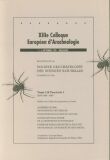 Fürst P.-A. & Mulhauser G. (eds) 1993:
Fürst P.-A. & Mulhauser G. (eds) 1993:
XIIIe Colloque Européen d’Arachnologie, 2–6 Septembre 1991 – Neuchâtel.
Bulletin de la Société Neuchâteloise des Sciences Naturelles, Neuchâtel 116 (1): 1–300. ISSN 0366-3469
Table of contents with separate PDFs
– Preface: 1-9 (PDF)
– Acosta L.E., 1993: Escorpiones y opiliones de la provincia de Córdoba (Argentina): diversidad y zoogeografía. 11–17 (PDF)
– Alderweireldt M. & Jocqué R., 1993: New data on Donacosa merlini (Araneae, Lycosidae), a threatened species?. 19–23 (PDF)
– Blick T. & Bliss P., 1993: Spinnentiere und Laukäfer am Waldrand (Arachnida: Araneae, Opiliones, Pseudoscorpiones; Insecta: Coleoptera: Carabidae). 25–34 (PDF)
– Bliss P., 1993: Neue Funde von Astrobunus laevipes (Arachnida, Opiliones, Phalangiidae). 35–39 (PDF)
– Boevé J.L., 1993: The injection of venom by a spider (Cupiennius salei, Ctenidae) and the weight of an insect prey (Acheta domesticus, Gryllidae). 41–47 (PDF)
– Buchar J., 1993: The use of faunistical data for biomonitoring. 49–57 (PDF)
– Canard A., 1993: Résistance à la sécheresse, revêtement tégumentaire et valence écologique de Salticides. 59–66 (PDF)
– Condé B., 1993: Le dimorphisme sexuel des Palpigrades. 67–73 (PDF)
– Fürst P.-A. & Blandenier G., 1993: Psilochorus simoni (Berland, 1911) (Araneae, Pholcidae): Découvertes de nouvelles stations suisses et discussions de son écologie. 75–85 (PDF)
– Coddington J.A. & Fürst P.-A., 1993: Proposed style for computer files of arachnological references. 87–97 (PDF)
– Hajer J., 1993: Notes on the spinning apparatus of the spiders Hyptiotes paradoxus C.L.K., 1834, and Uloborus walckenaerius Latr., 1806 (Araneae: Uloboridae). 99–103 (PDF)
– Hänggi A., 1993: Minimale Flächengrösse zur Erhaltung standorttypischer Spinnengemeinschaften – Ergebnisse eines Vorversuches. 105–112 (PDF)
– Haupt J., 1993: Lebensdauer von mesothelen Spinnen. 113–116 (PDF)
– Judson M.L.I., 1993: The gonosacs (‘gonopods’) of female pseudoscorpions (Arachnida, Chelonethi). 117–124 (PDF)
– Kajak A., 1993: Long-term changes in spider communities of drained fens. 125–131 (PDF)
– Koomen P., 1993: Experiences with Spider Exhibitions in The Netherlands. 133–139 (PDF)
– Koponen S., 1993: On the biogeography and faunistics of European spiders: latitude, altitude and insularity. 141–152 (PDF)
– Kuhn-Nentwig L. & Nentwig W., 1993: Zur Biochemie des Giftes von Cupiennius salei (Ctenidae). 153–159 (PDF)
– Luczak J., 1993: Ecotone zones between forest islands and crop fields in the Masurian Lakeland, Poland, as barriers for migration of spiders to crop fields. 161–167 (PDF)
– Malli H. & Nentwig W., 1993: Ontogenetische Aspekte der Giftdrüsen und des Giftes von Cupiennius salei (Araneae: Ctenidae). 169–175 (PDF)
– Marc P., 1993: Interspecific and intraspecific interactions between spider species from apple orchards. 177–184 (PDF)
– Mülhauser B. & Curty J., 1993: Comparaison de 2 méthodes d’étude sur l’écologie et la structure des peuplements d’araignées des lisières. 185–193 (PDF)
– Prószyński J., 1993: Zoogeographical features of the European Fauna of Salticidae (Araneae), an overview of 80 years of research. 195–198 (PDF)
– Ramousse R., 1993: Allométrie de la reproduction chez les femelles d’Araneus (Larinioides) suspicax 0. Pickard-Cambridge 1876, élevées en laboratoire. 199–208 (PDF)
– Ruzicka V., 1993: Structure and ecology of invertebrates communities of stony debris in Czech Republic. Research project. 209–214 (PDF)
– Schmidt G., 1993: Further crossing experiments in Latrodectus species (Araneida: Theridiidae). 215–222 (PDF)
– Simon U., 1993: Temporal species serie of web-spiders (Arachnida: Araneae) as a result of pine tree bark-structure. 223–227 (PDF)
– Studer A. & Nentwig W., 1993: Zur Beutetierspezifität des Giftes von Cupiennius salei (Araneae: Ctenidae). 229–235 (PDF)
– Tarabaev C., 1993: Karakurt (spider genus Latrodectus) in Kazachstan: distribution and problem of victim registration. 237–240 (PDF)
– Tongiorgi P. & Sola C., 1993: Pardosa nigristernis Denis, 1966. A North African component of the Italian and Spanish arachnofauna. 241–244 (PDF)
– Uhl G., 1993: Sperm storage and repeated egg production in female Pholcus phalangioides Fuesslin (Araneae). 245–252 (PDF)
– van Helsdingen P.J., 1993: Can Macrothele calpeiana (Walckenaer) (Araneae, Hexathelidae) be used as a bio – indicator?. 253–258 (PDF)
– Villepoux O., 1993: Remarques sur la répartition des araignées dans un marais de plaine. 259–268 (PDF)
– Ysnel F., 1993: Data points for a study of population dynamics of an Orb-Weaving spider (Larinioides cornutus, Araneae, Araneidae). 269–278 (PDF)
– Zyuzin A.A., Tarabaev C. & Fyodorov A.A., 1993: The spider fauna of the Karatau montain range. 279–285 (PDF)
Notes diverses et résumés:
– Decae A.E., 1993: The trapdoor-burrow: the success of a defense system. 287–292 (PDF)
– Zwörner-Weickmann D., Moosmann S. & Formella M., 1993: Springspinnen Interessante Beobachtungen bei der Haltung und Zucht von Salticiden. 293–294 (PDF)
– Zwörner-Weickmann D. & Moosmann S., 1993: Neue Erfahrungen mit Giftspinnen. 295–297 (PDF)
– Lang A., 1993: Silk of the nuptial gift of the spider Pisaura mirabilis. 298 (PDF)
– Maurer R., 1993: Zur Gattung Cybaeus im Alpenraum (Araneae: Agelenidae, Cybaeinae). 299 (PDF)
12. ESA, Paris, France 1990
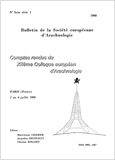 Célérier M.-L., Heurtault J. & Rollard C. (eds) 1990:
Célérier M.-L., Heurtault J. & Rollard C. (eds) 1990:
Comptes rendus du XIIème Colloque européen d’Arachnologie.
Bulletin de la Société européenne d’Arachnologie No. hors serie 1, Paris, 370 pp. ISSN 0995-1067
Table of contents with separate PDFs
– Alicata P., Cantarella T. & di Franco F., 1990: Distribution of the spiders in the forest ecosystems of the Nebrodi Mounts (Sicily). 1–4 (PDF)
– Anglade F., Ricordel I. & Goyffon M., 1990: Données spectroscopiques sur la fluorescence de la cuticule de Scorpion. 5–9 (PDF)
– Baert L., Maelfait J.-P. & Desander K, 1990: A preliminary study of the spider communities of Isla Isabela (Galapagos archipelago, Ecuador). 10–16 (PDF)
– Barthel J. & von Helversen O., 1990: Pardosa wagleri (Hahn 1822) and Pardosa saturatior Simon 1937, a pair of sibling species (Araneae, Lycosidae). 17–23 (PDF)
– Billiald P., Motta G. & Goyffon M., 1990: Progrès récents dans la chimiotaxonomie des Scorpions. 24–30 (PDF)
– Bliss P., 1990: Leiobunum limbatum (Arachnida, Opiliones) in der DDR: Verbreitungsmuster, Synanthropie und Arealexpansion. 31–35 (PDF)
– Bonaric J.-C. & Emerit M., 1990: Le système neuroendocrine rétrocérébral des araignées orthognathes. 36–43 (PDF)
– Canard A., 1990: Éléments pour une biologie de population de Pardosa nigriceps (Thorell, 1856). 44–49 (PDF)
– Célérier M.-L., Paris C., Lange C. & Basselier J.-J., 1990: Trente ans d’étude des venins d’animaux et particulièrement ceux des araignées Theraphosides. 50–59 (PDF)
– Célérier M.-L., Paris C., Lange C. & Basselier J.-J., 1990: Contribution à la connaissance du venin de la Mygale africaine Scodra griseipes Pocock, 1897 (Theraphosidae). 60–63 (PDF)
– Condé B., 1990: L’aire génitale mâle des Palpigrades. 64–69 (PDF)
– Cordes D. & von Helversen O., 1990: Indications for the existance of Alopecosa barbipes (Sundevall 1832) as a ‘sibling species’ to Alopecosa accentuata (LatreiIle 1817) – Results of morphological, ethological and biogeographical studies. 70–74 (PDF)
– Couvreur J.M., 1990: Le comportement de “présentation d’un leurre” chez Zodarion rubidum (Zodariidae). 75–79 (PDF)
– Curcic B.P.M., 1990: Cave pseudoscorpions of eastern Serbia: origin and biogeographical implications. 80–89 (PDF)
– Curcic B.P.M. & Dimitrijevic R.N., 1990: Teratological variation in Chthonius ischnocheles (Hermann) and C. aff. tetrachelatus (Preyssler) (Chthoniidae, Pseudoscorpiones). 90–96 (PDF)
– Curtis D.J. & Corrigan H., 1990: Peatland spider communities and land management on a scottish island. 97–102 (PDF)
– Curtis D.J., Curtis E.J. & Thompson D.B.A., 1990: On the effects of trampling on montane spiders and other arthropods. 103–109 (PDF)
– Decae A.E., 1990: Ambush Hunting in Spiders with special reference to the hunting behaviour of Segestria florentina, Rossi and the feeding of Sericopelma rubronitens, Ausserer (Araneae). 110–117 (PDF)
– Dimitrijevic R.N., 1990: Segmental and other malformations in Neobisium simoni (L. Koch) and N. bernardi Vachon (Neobisiidae, Pseudoscorpiones) from France. 118–124 (PDF)
– Emerit M. & Bonaric J.-C., 1990: Richesse, diversité spécifiques et distribution d’abondance du peuplement arachnologique d’une garrigue languedocienne. 125–133 (PDF)
– Joachim Haupt J., 1990: Comparative Morphology and Phylogeny of Liphistiomorph Spiders (Araneida: Mesothelae). III. Provisional diagram of relationships in Heptathelidae. 134–140 (PDF)
– Jacqueline Heurtault J. & G Vannier G., 1990: Modes de transpiration chez les Pseudoscorpions hygrophiles et xérophiles. 141–152 (PDF)
– Hofmann I. & Joachim Haupt J., 1990: Spatial and temporal distribution of five syntopic species of the genus Alopecosa (Araneae, Lycosidae) and some remarks on their ecology. 153–158 (PDF)
– Judson M.L.I., 1990: The remarkable protonymph of Pseudochthonius (Chelonethi, Chthoniidae). 159–165 (PDF)
– Kajak A., 1990: Intensity of area searching in grasslands and grassland borders by some dominant spider species. 166–171 (PDF)
– Kessler A. & Laan F.P.J., 1990: The role of Pheromones in the distribution of Spiders in the forest litter layer. 172–177 (PDF)
– Lange C. & Paris C., 1990: La spectrométrie de masse: une technique puissante pour l’analyse de constituants biologiques / Mass spectrometry: a useful tool for biological analysis. 178–215 (PDF)
– Lange C., Paris C., Célérier M.-L., Cherton J.-C. & Basselier J.-J., 1990: Cartographie du venin de Scodra griseipes (Theraphosidae). 216–223 (PDF)
– Leborgne R. & Alain Pasquet A., 1990: Approche Éco-Éthologique d’araignées à toile: exemple de Zygiella x-notata Clerck. 224–228 (PDF)
– Lourenço W.R., 1990: Modelès de stratégie reproductrice chez les Scorpions; corrélation avec des centres d’endémisme dans la région néotropicale. 229–234 (PDF)
– Luczak J., 1990: Ecotone spiders. 235–241 (PDF)
– Maelfait J.-P., Hendrik Segers H. & Léon Baert L., 1990: A preliminary analysis of the forest floor spiders of Flanders (Belgium). 242–248 (PDF)
– Marc P., 1990: Essai préliminaire d’utilisation d’Aranéides contre l’Anthonome du pommier (Anthonomus pomorum L.) (Coleoptera: Curculionidae) dans un verger non traité. 249–254 (PDF)
– Marc P., 1990: Données sur le peuplement d’Aranéides des troncs de pins. 255–260 (PDF)
– Milanovic M.M., 1990: A survey of the fauna of harvestmen (Opiliones, Arachnida) of the National Park Durmitor (Montenegro, Yugoslavia). 261–265 (PDF)
– Mulhauser B., 1990: La bioindication?… Et si nous reparlions des araignées?. 266–272 (PDF)
– Nährig D., 1990: Influence of different pesticides on Spider communities in a Riparian forest of the Rhine river. 273–279 (PDF)
– Pasquet A., Leborgne R., Trabalon-Pouzol M. & Assi-Bessekon D., 1990: Fermeture du groupe chez une araignée sociale Anelosimus eximius? Approche éthologique, génétique et biochimique. 280–285 (PDF)
– Prieto C.E., 1990: The genus Ischyropsalis C.L. Koch (Opiliones, Ischyropsalididae) on the Iberian Peninsula. II: Troglobitic species. 286–292 (PDF)
– Rambla M., 1990: Les scopula des Opilions, différences avec les scopula des araignées (Arachnida, Opiliones, Araneae). 293–298 (PDF)
– Rambla M. & Perera A., 1990: Contribution à la connaissance des espèces du genre Mastobunus Simon (Opiliones, Palpatores, Sclerosomatidae). 299–302 (PDF)
– Ramousse R., 1990: Polymorphisme et reproduction chez les mâles d’une araignée orbitèle, Larinioides suspicax (Araneae: Araneidae). 303–309 (PDF)
– Schmidt G., 1990: Zur Spinnenfauna der Wüsteninsel Sal (Republica de Cabo Verde). 310–313 (PDF)
– Segers H. & Maelfait J.-P., 1990: Field- and laboratory observations on the life cycle of Cœlotes terrestris and C. inermis (Araneae: Agelenidae). 314–324 (PDF)
– Steinberger K.-H., 1990: Phenology and Habitat-selection of “xerothermic” spiders in Austria (Lycosidae, Gnaphosidae). 325–333 (PDF)
– Stockmann R., 1990: Un organe provisoire des pédipalpes chez des embryons de scorpions: une tétine à deux niveaux de pression chez les scorpions vivipares. 334–339 (PDF)
– Stumpf H., 1990: Observations on the copulation behaviour of the sheet-web spiders Linyphia hortensis Sundevall and Linyphia triangularis (Clerck) (Araneae: Linyphiidae). 340–345 (PDF)
– Tarabajev C., 1990: Winter frosts and late frosts as the reason of karakurt (Black Widow Spider, Latrodectus tredecimguttatus) depresssion in Kazakhstan. 346–348 (PDF)
– Töpfer-Hofmann G. & von Helversen O., 1990: Four species of the Pardosa lugubris-group in Central Europe (Araneae, Lycosidae) – A preliminary report. 349–352 (PDF)
– van Helsdingen P.J., 1990: The presence of Segestria florentina (Rossi) in the Netherlands. 353–357 (PDF)
– Villepoux O., 1990: Les araignées de la réserve naturelle du Marais de Lavours. 358–366 (PDF)
– Weickmann D., Formella M. & Moosmann S., 1990: Höhlenbewohnende Spinnen und ihre Verwendbarkeit als Bioindikatoren. 367–370 (PDF)
11. ESA, Berlin, Germany 1988
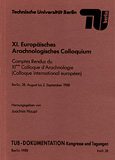 Haupt J. (ed) 1988:
Haupt J. (ed) 1988:
XI. Europäisches Arachnologisches Colloquium.
Technische Universität Berlin, 354 pp. (TUB-Dokumentation Kongresse und Tagungen, Heft 38). ISBN 3-7983-1257-1
Table of contents with separate PDFs
– Sommaire – Inhalt – Contents
SINNESPHYSIOLOGIE UND ETHOLOGIE
– Barth F.G., 1988: Vibrations and spider behaviour. 10–21 (PDF)
– Seyfarth E.A. & Hammer K., 1988: Central projections of cuticular mechanoreceptors in spiders: the specificity of proximal leg sensilla. 23–28 (PDF)
– Krapf D., 1988: Prey localization by trichobothria of scorpions. 29–34 (PDF)
– Krafft B., Macel M. & Roland C., 1988: Complémentarité des signaux intervenant dans les rapprochement des sexes chez Tegenaria domestica (Agelenidae). 35–40 (PDF)
– Sébrier M.-A. & Krafft B., 1988: Modification du comportement d’ingestion de l’araignée Zygiella x-notata: Influence d’une proie préalablement capturée sur une proie en cours de consommation. 41–46 (PDF)
– Fernandez C., Ortega J. & Pablos E., 1988: Agonistic behaviour in Lycosa tarentula fasciiventris Dufour (Araneae, Lycosidae). 47 (PDF)
– Toft S., 1988: Interference by web take-over in sheet-web spiders. 48–59 (PDF)
ENTWICKLUNG UND PARASITISMUS
– Canard A., 1988: Der Anfang der postembryonalen Entwicklung bei Dysdera. Sollen wir die Eizähne berücksichtigen, um die Entwicklungsstadien zu zählen? 61–71 (PDF)
– Ysnel F., 1988: Caractérisation des stades de développement de Larinioides cornutus (Clerck, 1757) (Araneae, Argiopidae) par la trichobothriotaxie. 72–78 (PDF)
– Hajer J., 1988: The postembryonic development of the spinning apparatus in cribellatae spiders, and its utilizing in solving phylogenetic problems. 79–88 (PDF)
– Ćurčić B.P.M. & Rajko N Dimitrijević R.N., 1988: Segmental deficiencies in some Neobisiidae (Pseudoscorpiones, Arachnida). 89–97 (PDF)
– Rollard C., 1988: Données biologiques sur Gelis melanocephala Schrk. (Ichneumonidae, Cryptinae) consommateurs d’oeufs de plusieurs espèces d’araignées en landes armoricaines. 98–103 (PDF)
– Sacher P., 1988: Eiparasitierung bei Argiope bruennichi (Scopoli) durch die Schlupfwespe Tromatobia ornata Gravenhorst. 104–108 (PDF)
ÖKOLOGIE
– Maelfait J.-P. & Baert L., 1988: L’usage pratique des araignées en tant qu’indicateurs écologiques. 110–118 (PDF)
– Weiss I., 1988: Ökologie der Spinnen und Weberknechte in südosteuropaischen Waldsteppen. 119–131 (PDF)
– Buchar J., 1988: Eine quantitative Schätzung der Arachnofauna Böhmens. 132 (PDF)
– Steinberger K.-H., 1988: Ein Beitrag zur thermophilen Spinnenfauna Österreichs. 133–137 (PDF)
– Hofmann I., 1988: Spider communities (Arachnida: Araneae) of different xerothermic biotopes. 138–147 (PDF)
– Koponen S., 1988: Effect of fire on spider fauna in subarctic birch forest, Northern Finland. 148–153 (PDF)
– Segers H. & Maelfait J.-P., 1988: A comparative study of the spider communities of different woodland habitats. 154–160 (PDF)
– Decleer K., 1988: Temporary inundation as a determining factor for the spider communities of marshland habitats. 161–167 (PDF)
– Mulhauser B. & Mulhauser G., 1988: Comparaison entre les peuplements d’araignées épigées d’un haut-marais et d’un bas-marais lacustre jurassiens. 168 (PDF)
– Alderweireldt M. & De Keer R., 1988: Comparison of the life cycle history of three Oedothorax-species (Araneae, Linyphiidae) in relation to laboratory observations. 169–177 (PDF)
– Jędryczkowski W.B., 1988: The distribution and ecology of pseudoscorpiones in Poland. 178–187 (PDF)
– Kajak A. & Kaczmarek M., 1988: Effect of predation on soil mesofauna: an experimental study. 188–198 (PDF)
– Łuczak J., 1988: Spider communities under agricultural and industrial pressure. 199–206 (PDF)
– Stenholt Clausen I.H., 1988: A budget for Cd and Pb in Steatoda bipunctata (Araneae: Theridiidae). 207 (PDF)
– Platen R., 1988: Diurnale Rhythmik von Spinnen (Araneida) und Weberknechten (Opilionida) in unterschiedlichen Biotoptypen von Berlin (West). 208–220 (PDF)
FAUNISTIK UND TAXONOMIE
– Legg G. & Pabs-Garnon E.B., 1988: The life history of a tropical forest cyphophthalmid from Sierra Leone (Arachnida, Opiliones). 222–230 (PDF)
– Schwendinger P., 1988: Biological observations on orthognathous spiders in Northern Thailand (Araneae: Mesothelae, Mygalomorphae). 231–237 (PDF)
– Baehr B., 1988: Zur Systematik, Phylogenie und Zoogeographie der Tamopsis arnhemensis – circumvidens – tropica Gruppe (Araneae, Hersiliidae) aus Australien. 238–249 (PDF)
– Bosmans R. & Beladjal L., 1988: The genus Harpactea in North Africa (Araneae: Dysderidae). 250–255 (PDF)
– Schmidt G., 1988: Zur Spinnenfauna der Makaronesischen Inseln. 256–260 (PDF)
– Ovtsharenko V.I., 1988: The faunogenetic composition of spiders of the family Gnaphosidae of the U.S.S.R.. 261–266 (PDF)
– Ribera C., 1988: La familia Leptonetidae (Arachnida, Araneae) en la peninsula Iberica. 267–281 (PDF)
– Pròszynski J., 1988: Conclusions to the origin of the European fauna of Salticidae (Araneae) from the studies of the Near East fauna. 282–286 (PDF)
– Ćurčić B.P.M., 1988: Some remarks on the evolution of dinaric cave pseudoscorpions. 287–292 (PDF)
– Deltshev C., 1988: The genus Fageiella Kratochvil and the genus Anthrohyphantes Dumitresco (Araneae, Linyphiidae, Lepthyphanteae) in the caves of Balkan peninsula. 293–302 (PDF)
– Juberthie C., 1988: Les opilions cyphophthalmes: Biogéographie, vitesse d’évolution, périodes de colonisation du milieu souterrain. 303–308 (PDF)
– Mučalica M., 1988: The review of the fauna of harvestmen (Opiliones, Arachnida): investigations in Yugoslavia. 309–315 (PDF)
– Moter S., 1988: Variability of morphological characters of Androctonus australis (Linne, 1758) (Scorpiones, Buthidae). 316–317 (PDF)
– Wolf A., 1988: Differentiation between Cheiracanthium erraticum and Cheiracanthium pennyi. 318 (PDF)
– Renner F., 1988: Liste der im Krieg vernichteten Typen des Königlichen Naturalienkabinetts in Stuttgart. 319–329 (PDF)
MORPHOLOGIE UND PHYSIOLOGIE
– Alberti G., 1988: Sperm aggregations in Arachnida. 331 (PDF)
– Lopez A. & Juberthie-Jupeau L., 1988: Structure et ultrastructure de la glande labio-sternale chez Theridiosoma splendidum (Tacz.) (Araneae: Theridiosomatidae). 332–339 (PDF)
– Rambla M., 1988: The surface integument ultrastructure of Stylocellus silhavyi Rambla 1988 (Opiliones, Cyphophthalmi, Stylocellidae). 340 (PDF)
– Perera A. & Rambla M., 1988: A new ultrastructure of the calcaneus and the tarsus of the opilionid Anelasmocephalus cambridgei (Westwood, 1874) (Arachnida, Opiliones, Palpatores, Trogulidae). 341 (PDF)
– Lourenço W.R., Kovoor J. & Muñoz-Cuevas A., 1988: Observations on spiders in ultraviolet light. 342–349 (PDF)
– Holl A. & Henze M., 1988: Pigmentary constituents of yellow threads of Nephila webs. 350 (PDF)
10. ESA, Rennes, France 1987
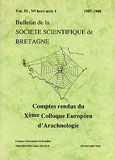 Alain Canard (ed) 1988:
Alain Canard (ed) 1988:
Comptes rendu du Xème Colloque Européen d’Arachnologie (1988).
Bulletin de la Société Scientifique de Bretagne, Rennes 59, H.S. 1: 1–221.
Table of contents with separate PDFs
– Préface (PDF)
– Alderweireldt M. & Maelfait J.-P., 1988: Life cycle, habitat choice and distribution of Pardosa amentata (Clerck, 1757) in Belgium, (Araneae, Lycosidae). 7–15 (PDF)
– Baert L. & Maelfait J.-P., 1988: Araignées des versants d’exposition Nord et Sud d’une autoroute en tranchée dans une colline sablonneuse 17–24 (PDF)
– Blandin P., 1988: La signification écologique de la prédation entre araignées. 25 (PDF)
– Bonaric J.-C., 1988: Présence de composés apparentés aux hormones juvéniles (JH) d’insectes chez les arachnides: détection et difficultés d’interprétation. 27–36 (PDF)
– Bonnet P., 1988: Les juvaranes. 37–38 (PDF)
– Boulanger P., 1988: Effet de l’immobilisation d’un pédipalpe du male sur l’activité pré-copulatoire de Tegenaria domestica (Clerck). 39–42 (PDF)
– Célérier M.-L., 1988: Quantité de soie produite au cours du cycle de développement chez quelques espèces d’araignées en élevage. 43–52 (PDF)
– Emerit M. & Bonaric J.C., 1988: Contribution à l’étude du développement postembryonnaire de Filistata insidiatrix (Forskal): la trichobothriotaxie et son évolution. 53–63 (PDF)
– Fouillet P., 1988: Les aranéides des schorres de la baie du Mont Saint-Michel: distribution et relations avec les facteurs mésologiques. 65–86 (PDF)
– Gundermann J.-L., 1988: Le gardiennage chez Coelotes terrestris (Wider) (Araneae, Agelenidae). 87–90 (PDF)
– van Helsdingen P.J., 1988: Note provisoire sur la répartition des espèces du genre Segestria aux Pays-Bas (Araneae, Segestridae). 91–98 (PDF)
– Hofmann I., 1988: Associations of spider families (Arachnida: Araneae) of different habitats. 99–108 (PDF)
– Jocqué R., 1988: La glande fémorale des Zodariinae (Araneae, Zodariidae). 109–114 (PDF)
– Juberthie-Jupeau L. & Lopez A., 1988: Les glandes segmentaires rétro-gnathocoxales de Lepthyphantes sanctivicentii (Simon, 1872) (Araneae: Linyphiidae): structure et ultrastructure. 115–129 (PDF)
– Judson M.L., 1988: Sur la présence en France de Chthonius (C.) halberti Kew et de Chthonius (C.) ressli Beier avec remarques sur le rang de Kewochthonius Chamberlin et de Neochthonius Chamberlin (Arachnida, Chelonethida, Chthoniidae). 131 (PDF)
– Kessler A. & van der Ham N., 1988: Microhabitat selection in some linyphiid spiders inhabiting the forest floor. 133–138 (PDF)
– Kremer P., 1988: Aspect ontogénétique des interactions chez Zygiella x-notata (Clerck). 139–142 (PDF)
– Leborgne R. & Pasquet A., 1988: Étude préliminaire de la stratégie reproductrice d’Argiope bruennichi (Scopoli): Production de cocons. 143–146 (PDF)
– Lourenço W.R., 1988: Première évidence de la présence d’une faune scorpionique amazonienne relictuelle dans les “Brejos” de la Caatinga du Nord-Est du Brésil. 147–154 (PDF)
– Maelfait J.-P. & Léon Baert L., 1988: Les araignées sont-elles de bons indicateurs écologiques?. 155–160 (PDF)
– Mahnert V., 1988: Neobisium carcinoides (Hermann, 1804) (Pseudoscorpionida: Neobisiidae) — une espèce polymorphe?. 161–174 (PDF)
– Pasquet A. & Leborgne R., 1988: Interception et capture des proies chez 4 espèces d’araignées orbitèles. 175–178 (PDF)
– Prószyński J., 1988: 30 years after Bibliographia Araneorum of Piere Bonnet – what next?. 179–181 (PDF)
– Rambla M. & Lopez A., 1988: Contribution à la connaissance d’Holoscotolemon querilhaci (Lucas, 1864) (Arachnida, Opiliones, Laniatores, Cladonychiidae). 183–194 (PDF)
– Roland C., 1988: Aspect ontogénétique de l’émission et de la réception de signaux chimiques sexuels chez Tegenaria domestica (Agelenidae). 195–198 (PDF)
– Rollard C., 1988: Impact d’Hyménoptères du genre Gelis (Ichneumonidae, Cryptinae) sur quelques populations d’aranéides, en landes armoricaines. 199–204 (PDF)
– Segers H. & Maelfait J.-P., 1988: Faunistical observations on the spider fauna of the zonien forest (Belgium). 205–206 (PDF)
– Villepoux O., 1988: Sur quelques espèces d’araignées rares ou nouvelles, des tourbières d’Auvergne. 207 (PDF)
– Ysnel F. & Ledoux J.C., 1988: Données sur le cycle biologique de quelques araignées des terres australes françaises (Kerguelen, Crozet). 209–221 (PDF)
9. ESA, Brussels, Belgium 1985
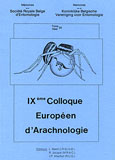 Baert L., Jocqué R. & Maelfait J.-P. (eds) 1986:
Baert L., Jocqué R. & Maelfait J.-P. (eds) 1986:
IXème Colloque Européen d’Arachnologie.
Mémoires de la Société Royale Belge d’Entomologie 33: 1-224. ISSN 0374-6038
Table of contents with separate PDFs
– Préface (PDF)
– André H.M. & Jocqué R., 1986: Definition of stases in spiders and other arachnids. 1–14 (PDF)
– Bara L., 1986: Écologie des Araignées calcicoles de la région de Viroinval (Belgique) I. 15–24 (PDF)
– Blandin P. & Célérier M.-L., 1986: L’étude des stratégies démographiques chez les Araignées. 25–35 (PDF)
– Bonaric J.-C., Michel Emerit M. & R Calderon R., 1986: Utilisation des barèmes trichobothriotaxiques comme critère d’âge chez la mygale Tryssothele pissii (Araneae, Dipluridae). 37–46 (PDF)
– Canard A., 1986: Données sur le développement, la croissance, le cycle biologique et l’évolution démographique de la Mygale (Atypus affinis Eichwald, 1830) (Atypidae, Mygalomorpha). 47–56 (PDF)
– Célérier M.-L., 1986: Bilans énergétiques individuels, en élevage, de deux Lycosidae d’une savane africaine (Lamto, Côte d’Ivoire): Brevilabus (?) gillonorum Cornic, 1980 et Hippasa lamtoensis Dresco, 1981. 57–66 (PDF)
– Condé B., 1986: Les Palpigrades du nouveau monde: état des connaissances. 67–73 (PDF)
– Ćurčić B.P.M., 1986: On the taxonomy and biogeography of Microcreagris-related genera in Eurasia (Neobisiidae, Pseudoscorpiones). 75–79 (PDF)
– Ćurčić B.P.M. & Dimitrijević R., 1986: Teratology of abdominal tergites and sternites in Neobisium carpaticum Beier (Neobisiidae, Pseudoscorpiones). 81–84 (PDF)
– van Helsdingen P., 1986: Discrimination between Xysticus luctuosus (Blackwall) and X. acerbus Thorell (Araneae, Thomisidae). 85–92 (PDF)
– Jocqué R., 1986: Etude de l’aranéofaune d’un gradient d’humidité dans une bruyère campenoise (Belgique). 93–106 (PDF)
– Kekenbosch J., 1986: Historique et évolution de l’Aranéologie en Belgique. 107–109 (PDF)
– Kovoor J., 1986: Affinités de quelques Pholcidae décelables à partir des caractères de l’appareil séricigène. 111–118 (PDF)
– Lopez A., Juberthie-Jupeau L. & Stowe M., 1986: L’appareil séricigène de Kaira alba (Hentz) (Araneae: Araneidae). 119–128 (PDF)
– Lourenço W.R., 1986: Biogéographie et phylogénie des Scorpions du genre Rhopalurus Thorell, 1876 (Scorpiones, Buthidae). 129–137 (PDF)
– Maelfait J.-P. & Baert L., 1986: Observations sur les Lycosides des îles Galápagos. 139–142 (PDF)
– Mahnert V., 1986: Une nouvelle espèce du genre Tyrannochthonius Chamb. des îles Canaries, avec remarques sur les genres Apolpiolum Beier et Calocheirus Chamberlin (Arachnida, Pseudiscorpiones). 143–153 (PDF)
– Perez J.A. & Blasco A., 1986: Nota sobre los Prodidominae (Araneae, Gnaphosidae) de la Peninsula Iberica. 155–164 (PDF)
– Proszynski J., 1986: Remarques sur la composition de la faune européenne, sa répartition et son origine basées sur les études des Salticidae. 165–170 (PDF)
– Rambla M. & Fontarnau R., 1986: Les Opilions Cyphophthalmes (Arachnida) de la faune ibérique: III. Sur Odontosiro lusitanicus Juberthie, 1961. 171–178 (PDF)
– Ramousse R., 1986: L’Oophagie au cours des stades grégaires chez Araneus suspicax (O. Picard-Cambridge). 179–186 (PDF)
– Ribera C. & Barrientos J.A., 1986: Sobre algunas Tegenarias cavernicolas poco conocidas del Mediterraneo español. 187–197 (PDF)
– Rollard C., 1986: Données sur la consommation d’oeufs d’Agroeca (Clubionidae) par des Hyménoptères Cryptinae du genre Gelis. 199–206 (PDF)
– Schmidt G., 1986: Betrachtungen zur Werbung und Begattung der Herbstradspinne Metellina segmentata (Clerck) (Araneae, Araneidae). 207–211 (PDF)
– Ysnel F. & Canard A., 1986: Réflexions sur les cycles vitaux des Araignées européennes, l’exemple des espèces à toiles géométriques. 213–222 (PDF)
8. ESA, Moulis, France 1984
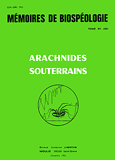 Juberthie C. (ed) 1986:
Juberthie C. (ed) 1986:
Arachnides Souterrains.
Mémoires de Biospéologie 12 (39): 1–160. ISSN 0398-7973
Table of contents with separate PDFs
Arachnides Souterrains. Mémoires de Biospéologie (PDF)
– Lourenço W.R. & Francke O.F., 1986: Révision des connaissances sur les Scorpions cavernicoles (Troglobies) (Arachnida, Scorpions). Mémoires de Biospéologie 12 (39): 3–7 (PDF)
– Vachon M. & Lourenço W.R., 1986: Scorpions cavernicoles du Sarawak (Bornéo), Chaerilus chapmani n. sp. (Chaerilidae) et Lychas hosei (Pocock, 1890) (Buthidae). Mémoires de Biospéologie 12 (39): 9–18 (PDF)
– Heurtault J., 1986: Pseudoscorpions cavernicoles de France: Revue synoptique. Mémoires de Biospéologie 12 (39): 19–32 (PDF)
– Condé B., 1986: Acquisitions récentes chez les Palpigrades. Mémoires de Biospéologie 12 (39): 33–35 (PDF)
– Deeleman-Reinhold C.L., 1986: Contribution à la connaissance des Lepthyphantes du groupe pallidus (Araneae, Linyphiidae) de Yougoslavie, Grèce et Chypre. Mémoires de Biospéologie 12 (39): 37–50 (PDF)
– Ribera C., Ferrández M.A. & Blasco A., 1986: Araneidos cavernicolas de Canarias II. Mémoires de Biospéologie 12 (39): 51–66 (PDF)
– Lopez A. & Emerit M., 1986: Wendilgarda mustelina arnouxi n. ssp. et la glande labiosternale des Theridiosomatidae (Araneae). Mémoires de Biospéologie 12 (39): 67–76 (PDF)
– Juberthie C., 1986: Cycle vital de Telema tenella dans la grotte-laboratoire de Moulis et stratégies de reproduction chez les Araignées cavernicoles. Mémoires de Biospéologie 12 (39): 77–89 (PDF)
– Emerit M., 1986: L’appareil glandulaire tégumentaire de la patte des Telemidae (Araneae). Un critère phylogénique? Mémoires de Biospéologie 12 (39): 91–96 (PDF)
– Lopez A. & Juberthie-Jupeau L., 1986: Ultrastructure comparée du tube séminifère chez les mâles d’araignées. Mémoires de Biospéologie 12 (39): 97–109 (PDF)
– Martens J. & Lingnau M., 1986: Die Weberknechte Scotolemon lespesi Lucas und Scotolemon lucasi Simon aus den Pyrenäen – Zwei valide Arten? (Arachnida: Opiliones: Phalangodidae). Mémoires de Biospéologie 12 (39): 111–126 (PDF)
– Muñoz-Cuevas A., 1986: Aspects comparatifs de la photoréception et de la vision nocturne des Arachnides. Mémoires de Biospéologie 12 (39): 127–134 (PDF)
– Palacios-Vargas J.G., Vasquez I.M. & Morales-Malacara J.B., 1986: Aspectos faunisticos y ecologicos de la gruta de Juxtlahuaca, Gro., Mexico. Mémoires de Biospéologie 12 (39): 135–142 (PDF)
CHRONIQUES:
– Juberthie C., 1986: Vladimir Silhavy V. (1913-1984). Mémoires de Biospéologie 12 (39): 145–146 (PDF)
– Delamare Deboutteville C. & Dumitresco M., 1986: Traian Orghidan (1917-1985). Mémoires de Biospéologie 12 (39): 147–153 (PDF)
7. ESA, Nancy, France 1982
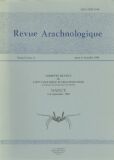 Krafft B., Leborgne R. & Roland C. (eds) 1984:
Krafft B., Leborgne R. & Roland C. (eds) 1984:
Comptes Rendus du VIIème Colloque d’Arachnologie (Colloque international européen). Nancy, 1–4 Septembre 1982.
Revue Arachnologique 5 (4): 111–373.
Table of contents with separate PDFs
– Préface 111–114 (PDF)
– Heurtault J., 1984: Identité d’Hypoctonus africanus Hentschel et d’Hypoctonus clarki Cooke et Shadab (Arachnides, Uropyges). 115–123 (PDF)
– Brignoli P.M., 1984: Problèmes taxonomiques des Amblypyges et des Arachnides avec spermatophores en général (Arachnida, Amblypygi). 125–132 (PDF)
– Condé B., 1984: Les Palpigrades: quelques aspects morpho-biologiques. 133–143 (PDF)
– Rambla M. & Fontarnau R., 1984: Les Opilions Cyphophthalmes (Arachnida) de la faune ibérique: I. sur Paramiopsalis ramulosus Juberthie, 1962. 145–152 (PDF)
– Barrientos J.A., 1984: Le statut taxonomique des Oxyopes Latreille, 1804, de la Péninsule Ibérique. 153–159 (PDF)
– Haupt J., 1984: Comportement sexuel, morphologie génitale et phylogenèse des araignées Liphistiomorphes. 161–168 (PDF)
– Canard A., 1984: Données sur la distribution spatio-temporelle des Theridiidae des landes armoricaines. 169–183 (PDF)
– Darchen R., 1984: Trois ans après… Variations de la densité de la répartition des colonies de l’araignée sociale Agelena consociata Denis dans la forêt gabonaise. 185–191 (PDF)
– Jocqué R., 1984: Considérations concernant l’abondance relative des araignées errantes et des araignées à toile vivant au niveau du sol. 193–204 (PDF)
– Legendre R., 1984: La répartition géographique des araignées marines du genre Desis (Desidae). 205–209 (PDF)
– Rollard C., 1984: Composition et structure de la biocénose consommatrice des Aranéides. 211–237 (PDF)
– Leborgne R., 1984: Spécificité d’organisation des comportements de cour des mâles de trois espèces d’Amaurobius (Araneae, Dictynidae). 239–245 (PDF)
– Olivera-Curotti G., 1984: Variations de l’organisation séquentielle des comportements prédateur et sexuel reliés à l’état physiologique chez Araneus suspicax (Pickard-Cambridge) (Argiopidae, Araneae). 1. Comportement Prédateur. 247–253 (PDF)
– Ramousse R. & Le Guelte L., 1984: Stratégies de construction de la toile chez deux espèces d’araignées (Araneus diadematus et Zygiella x-notata). 255–265 (PDF)
– Ramousse R. & Le Guelte L., 1984: Facteurs environnementaux et période “grégaire” chez l’araignée Araneus suspicax (O. Pickard-Cambridge) (Araneae, Argiopidae). 267–274 (PDF)
– Ramousse R. & Wurdak E., 1984: Biologie et comportement de la larve et de la première nymphe de l’araignée Araneus suspicax (O. Pickard-Cambridge). 275–286 (PDF)
– Wurdak E. & Ramousse R., 1984: Organisation sensorielle de la larve et de la première nymphe chez l’araignée Araneus suspicax (O. Pickard-Cambridge). 287–299 (PDF)
– Bonaric J.-C., Emerit M. & Legendre R., 1984: Le complexe neuroendocrine retrocerebral et la “glande de mue” de Filistata insidiatrix Forskol (Araneae, Filistatidae). 301–310 (PDF)
– Goyffon M., 1984: Scorpionisme et sérums antiscorpioniques. 311–319 (PDF)
– Weygoldt P., 1984: L’autotomie chez les Amblypyges. 321–327 (PDF)
– Foelix R., Jackson R.R., Henksmeyer A. & Hallas S., 1984: Tarsal hairs specialized for prey capture in the Salticid Portia. 329–334 (PDF)
– Callaini G. & Dallai R., 1984: Spermatozoides et phylogenèse chez les Garypides (Arachnida, Pseudoscorpions). 335–342 (PDF)
– Lopez A., 1984: Quelques points d’histologie comparée prososmatique chez les Oecobiidae et les Hersiliidae (Araneae). 343–353 (PDF)
– Emerit M., Bonaric J.-C. & Calderon G.R., 1984: Quelques particularités du développement de l’araignée chilienne Tryssothele pissii (Dipluridae): une contribution a la trichobothriotaxie des mygales. 355–362 (PDF)
RÉSUMÉS:
– Baert L. & Kekenbosch J., 1984: Les araignées de la Gaume (résumé). 363 (PDF)
– Horel A., Leborgne R. & Roland C., 1984: Influence de la mère et du groupement sur le développement des jeunes de Coelotes terrestris (résumé). 364 (PDF)
– Kovoor J., 1984: Anatomie, histologie et affinités de l’appareil séricigène des Hersilia Sav. & Aud. (Araneae, Hersiliidae) (résumé). 365 (PDF)
– Lourenço W.R., 1984: Importance de la pigmentation dans l’étude taxonomique des Buthidae néotropicaux (Arachnida, Scorpiones) (résumé). 366 (PDF)
– Muñoz-Cuevas A. & Boutier A., 1984: Mise en évidence du calcium++ dans les granules de pigments (ommochromes) de la rétine chez Acanthopachylus aculeatus, Pachylus chilensis et Ischyropsalis luteipes (Opilions, Arachnida) (résumé). 366–367 (PDF)
– Roland C., 1984: Communication chimique et vibratoire chez une araignée aquatique, Dolomedes triton (Pisauridae) (résumé). 367 (PDF)
– Stockmann R., 1984: Description du système endocrine chez les scorpions du genre Euscorpius (Chactidae) (résumé). 368–369 (PDF)
– Vachon M., 1984: Nouvel exemple du rôle important joué en taxonomie par la trichobothriotaxie du bras du pédipalpe chez les scorpions Buthidae (Arachnida): Lychas emiliae Werner, 1916 = Uroplectes emiliae (Werner, 1916) (résumé). 369 (PDF)
6. ESA, Modena, Italy 1981
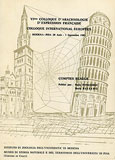 Tongiorgi P. & Balsamo M. (eds) 1981:
Tongiorgi P. & Balsamo M. (eds) 1981:
VIème Colloque d’Arachnologie d’Expression Française. Colloque International Européen.
Memorie Atti della Societa Toscana di Scienze Naturali, Pisa, ser. B suppl. vol. LXXXVIII. suppl. 88: 1–259; Pisa.
Table of contents with separate PDFs
– Contents (PDF)
– Préface (PDF)
MORPHOLOGIE ET HISTOLOGIE
– Kovoor J., 1981: Une source probable de phéromones sexuelles: les glandes tégumentaires de la région génitale des femelles d’Araignées. 1–15 (PDF)
– Callaini G., 1981: Étude comparative de la membrane pleurale des Pseudoscorpions au microscope électronique à balayage. 16–26 (PDF)
– Juberthie C., Lopez A. & Juberthie-Jupeau L., 1981: Étude ultrastructurale des sensilles thoraciques dorsales et paramédianes chez Sabacon paradoxum Simon (Palpatores, Sabaconidae). 27–33 (PDF)
– Legendre R. & Lopez A., 1981: Observations histologiques complementaires chez l’Araignée liphistiomorphe Heptathela kimurai Kishida, 1923 (Liphistiidae). 34–44 (PDF)
– Emerit M., 1981: Sur quelques formations tégumentaires de la patte de Telema tenella (Araignée, Telemidae), observées au microscope électronique à balayage. 45–52 (PDF)
– Kovoor J., Lopez A. & Emerit M., 1981: Des glandes tégumentaires particulières aux femelles chez Lepthyphantes sanctivincentii et Linyphia triangularis (Araneae, Linyphiidae). 53–60 (PDF)
ÉCOLOGIE ET BIOLOGIE
– Darchen R.J., 1981: Problèmes écologiques soulevés par une étude biométrique des individus de colonies de l’Araignée sociale, Agelena republicana Darchen (Aranéide, Labidognathe). 63–71 (PDF)
– Le Berre M., Ramousse R. & Le Guelte L., 1981: Éco-éthologie des Argiopidae: 1. Évolution temporelle d’une population d’Araneus diadematus Clerck dans son milieu naturel. 72–83 (PDF)
– Canard A., 1981: Utilisation comparée de quelques méthodes d’échantillonnage pour l’étude de la distribution des araignées en landes. 84–94 (PDF)
– Maelfait J.-P. & Bosmans R., 1981: Observations sur l’effort de reproduction de quelques Araignées. 95–99 (PDF)
– Legendre R., 1981: La reproduction par spermatophores chez les Araignées. 100–103 (PDF)
PHYSIOLOGIE ET ÉTHOLOGIE
– Giulio L., 1981: La perception visuelle du mouvement chez les Salticidae (Araneae). 107–119 (PDF)
– Bonaric J.-C., 1981: La régulation hormonale des phénomènes de mue et de diapause hivernale chez les Araignées. 120–131 (PDF)
– Leborgne R., 1981: Soie et communication chez les Araignées (le rapprochement des sexes). 132–142 (PDF)
– Robert T. & Krafft B., 1981: Contribution à l’étude des mécanismes de la communication tacto-chimique intervenant dans le rapprochement des sexes chez Pardosa hortensis Thorell (Araneae, Lycosidae). 143–153 (PDF)
– Roland C. & Ramousse R., 1981: Mise en évidence de l’intervention d’information tactochimique dans le rapprochement des sexes chez Araneus sclopetarius Clerck. 154–158 (PDF)
– Ramousse R., Le Guelte L. & Le Berre M., 1981: Organisation temporelle du comportement constructeur chez les Argiopidae. 159–172 (PDF)
– Le Guelte L., Ramousse R. & Le Berre M., 1981: L’analyse graphique appliquée à la toile géométrique des Araignées. 173–181 (PDF)
TAXONOMIE, PHYLOGÉNIE ET ZOOGÉOGRAPHIE
– Mahnert V., 1981: Sigles trichobothriaux chez les pseudoscorpions (Arachnida)v185–192 (PDF)
– Vachon M., 1981: Remarques sur la classification sous-spécifique des espèces appartenant au genre Euscorpius Thorell, 1876 (Scorpionida, Chactidae). 193–203 (PDF)
– Barrientos J.A., 1981: Discussion préliminaire du genre Lycosa Latr. 1804 dans la Péninsule Ibérique. 204–208 (PDF)
– Heurtault J., 1981: Présence et signification dans la France méditerranéenne des espèces des genres Beierochelifer, Cheirochelifer et Calocheiridius (Arachnides, Pseudoscorpions). 209–222 (PDF)
– Brignoli P.M., 1981:Vue d’ensemble sur les araignées d’Italie (Araneae). 223–233 (PDF)
– Kekenbosch J. & Baert L., 1981: Araignées du plateau des Hautes Fagnes (Belgique). 1ère partie: historique et faunistique. 234–243 (PDF)
– Dumitrescu D., 1981: L’état actuel des études arachnologiques en Roumanie. 244–255 (PDF)
– Brignoli P.M., 1981: Présent et futur de l’Arachnologie européenne. 256–259 (PDF)
5. ESA, Barcelona, Spain 1979
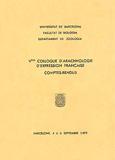 Rambla M. (ed) 1980:
Rambla M. (ed) 1980:
Comptes Rendus du Vème Colloque d’Arachnologie d’expression française.
Ediciones de la Universidad de Barcelona, Barcelona.
Table of contents with separate PDFs
– Préface (PDF)
– Barrientos J.A., 1980: L’identité de Tegenaria feminea E. Simon, 1870 (Agelenidae, Araneae). 15–20 (PDF)
– Bonaric J.-C. & Juberthie C., 1980: La glande de mue des araignées. Étude structurale et ultrastructurale de cette formation endocrine chez Pisaura mirabilis Cl. (Araneae-Pisauridae). 21–30 (PDF)
– Brignoli P.M., 1980: Sur la position taxonomique du genre Mecysmauchenius Simon, 1884 (Araneae, Archaeidae). 31–39 (PDF)
– Cabanac M. & Le Guelte L., 1980: Fièvre par prostaglandine chez les scorpions. 41 (PDF)
– Canard A., 1980: Quelques remarques à propos des premiers stades libres du développement post-embryonnaire des araignées. 43–52 (PDF)
– Roger M. & Darchen J., 1980: Les populations d’Agelena consociata, araignée sociale, dans la forêt primaire gabonaise. Leur repartion et leur densité. 53 (PDF)
– Emerit M., 1980: Une lacune de moins dans la faune malgache: La famille des Mimetidae (Araneae). 55–63 (PDF)
– Farradellas J.E., 1980: Quelques remarques à propos de Larca hispanica Beier et Larca spelaea Beier (Pseudoscorpionida, Garypidae). 65–70 (PDF)
– Gonzalez-Baschwitz G., 1980: Sur la présence de quelques types cellulaires dans l’hémolymphe d’Araneus diadematus. 71–81 (PDF)
– Gonzalez D., 1980: Scorpionisme en Espagne. 83–86 (PDF)
– Heurtault J., 1980: La néochétotaxie majorante prosomatique chez les Pseudoscorpions Neobisiidae: Neobisium pyrenaicum et N. mahnerti sp. n. 87–97 (PDF)
– Juberthie C. & Bonaric J.-C., 1980: Sur l’ultrastructure des organes oesophagiens des opilions et des organes de Schneider II des araignées. 99–109 (PDF)
– Juberthie C. & Lopez A., 1980: À propos du spermatophore et des sphérocristaux de l’araignée Telema tenella (Telemidae): quelques données ultrastructurales. 111–118 (PDF)
– Kovoor J. & Lopez A., 1980: Variation de l’appareil séricigène dans la famille des Araneidae: Cas des genre Cyclosa Menge et Nemoscolus Simon. 119–127 (PDF)
– Krafft B. & Roland C., 1980: Quelques remarques au sujet de la communication chimique chez les araignées. 129–135 (PDF)
– Le Berre M., 1980: Le rythme d’activité postembryonnaire: Évolution comparée pour 5 espèces d’Argiopidae au cours de la phase grégaire. 137–145 (PDF)
– Lopez A., Emerit M. & Rambla M., 1980: Contribution a l’étude de Sabacon paradoxum Simon 1879 (Opiliones, Palpatores, Ischyropsalididae). Stations nouvelles, particularités électromicroscopiques du prosoma et ses appendices. 147–161 (PDF)
– Lopez A., Juberthie-Jupeau L. & Ribera C., 1980: Les glandes gnathocoxale des Leptoneta (Araneae: Leptonetidae), structure, ultrastructure et intérêt systématique. 163–178 (PDF)
– Maelfait J.-P., Vanbiervliet T., Hublé J. & De Winne P., 1980: La compétition interspécifique a-t-elle joué un rôle dans l’évolution de la phénologie du cycle vital et du choix de l’habitat chez les araignées. 179–188 (PDF)
– Muñoz-Cuevas A. , 1980: Aspects phylétiques et ontogéniques de l’évolution régressives de l’oeil chez les Arachnides. 189–193 (PDF)
– Rambla M., 1980: Les Nemastomatidae (Arachnida, Opilions) de la Péninsule Ibérique. V. Nemastoma scabriculum Simon 1879 et Nemastoma hankiewiczii Kulczynski 1909. 195–202 (PDF)
– Ramousse R., 1980: Organisation temporelle du comportement constructeur chez huit espèces d’Argiopidées. 203–212 (PDF)
– Ribera C., 1980: Le genre Porrhomma dans les cavités de la Péninsule Ibérique. 213–216 (PDF)
– Vachon M., 1980: Remarques biogéographiques sur la faune des Scorpions de Madagascar à propos de l’utilisation de caractères trichobothriotaxiques permettant la distinction des genre Odonturus Karsch, 1879 et Tityobuthus Pocock, 1893. 217–224 (PDF)
4. ESA, Avignon, France, 1978
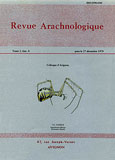 Revue Arachnologique 2 (4, 5, 6), 1979, pp. 133–314. ISSN 0398-4346
Revue Arachnologique 2 (4, 5, 6), 1979, pp. 133–314. ISSN 0398-4346
Table of contents with separate PDFs
– Préface. 133–135 (PDF)
– Farzanpay R. & Vachon M., 1979: Contribution à l’étude des caractères sexuels secondaires chez les scorpions Buthidae (Arachnida). Revue Arachnologique Tome 2, fasc. 4: 137–142 (PDF)
– Lopez A. & Emerit M., 1979: Données complémentaires sur la glande clypéale des Argyrodes (Araneae, Theridiidae). Utilisation du microscope électronique à balayage. Revue Arachnologique Tome 2, fasc. 4: 143–153 (PDF)
– Kovoor J., 1979: Les glandes séricigènes d’Uroctea durandi (Latreille) (Araneae, Oecobiidae). Révision, histochimie, affinités (Résumé). Revue Arachnologique Tome 2, fasc. 4: 155 (PDF)
– Darchen R., 1979: Relations entre colonies d’Agélénides sociaux du Gabon. Précisions sur les essaimages. II (Résumé). Revue Arachnologique Tome 2, fasc. 4: 156 (PDF)
– Horel A., Roland C. & Leborgne R., 1979: Mise en évidence d’une tendance au groupement chez les jeunes de l’araignée solitaire Coelotes terrestris. Revue Arachnologique Tome 2, fasc. 4: 157–164 (PDF)
– Krafft B. & Roland C., 1979: Un labyrinthe appliqué à l’étude des attractions sociales et sexuelles et de leur spécificité chez les araignées. Revue Arachnologique Tome 2, fasc. 4: 165–171 (PDF)
– Leborgne R. & Krafft B., 1979: Technique d’enregistrement et d’analyse des signaux vibratoires intervenant dans les comportements des araignées sédentaires. Revue Arachnologique Tome 2, fasc. 4: 173–182 (PDF)
– Ramousse R. & Le Guelte L., 1979: Relations spatio-temporelles dans le comportement constructeur chez l’Epeire diadème. Revue Arachnologique Tome 2, fasc. 4: 183–192 (PDF)
– Le Berre M., 1979: Modifications temporelles de l’activité chez de jeunes Argiopidés. Revue Arachnologique Tome 2, fasc. 5: 193–200 (PDF)
– Livecchi G., 1979: Ontogénèse du rythme du comportement constructeur chez Araneus diadematus. Revue Arachnologique Tome 2, fasc. 5: 201–203 (PDF)
– Bonaric J.-C., 1979: Effets des ecdysones et de l’hormone juvénile sur la durée du cycle de mue chez l’araignée Pisaura mirabilis Cl. (Araneae, Pisauridae). Revue Arachnologique Tome 2, fasc. 5: 205–207 (PDF)
– Goyffon M. & Francaz J.M., 1979: Activité électrique cérébrale spontanée du scorpion et amino-acides neurotransmetteurs. Revue Arachnologique Tome 2, fasc. 5: 209–212 (PDF)
– Lourenço W.R., 1979: A propos de la véritable identité des genres Rhopalurus Thorell, 1876 et Centruroides Marx, 1889 (Scorpiones, Buthidae). Revue Arachnologique Tome 2, fasc. 5: 213–219 (PDF)
– Estany J., 1979: À propos de quelques Pseudoscorpions des îles Canaries. Revue Arachnologique Tome 2, fasc. 5: 221–223 (PDF)
– Heurtault J., 1979: R. leclerci, deuxième espèce connue en France du genre Roncobisium (Arachnides, Pseudoscorpions, Neobisiidae). Revue Arachnologique Tome 2, fasc. 5: 225–230 (PDF)
– Heurtault J., 1979: Le sous-genre Ommatoblothrus en France (Pseudoscorpions, Neobisiidae). Revue Arachnologique Tome 2, fasc. 5: 231–238 (PDF)
– Leclerc P. & Heurtault J., 1979: Pseudoscorpions de l’Ardèche. Revue Arachnologique Tome 2, fasc. 5: 239–247 (PDF)
– Mahnert V., 1979: L’identité de Olpium chironomum L. Koch (Pseudoscorpions, Neobisiidae). Revue Arachnologique Tome 2, fasc. 5: 249–252 (PDF)
– Muñoz-Cuevas A. & Vachon M., 1979: Données sur le développement postembryonnaire du tarse chez les Triaenonychidae et considérations sur la phylogénie de cette famille dans l’Amérique australe (Opilions, Arachnida). Revue Arachnologique Tome 2, fasc. 6: 253–257 (PDF)
– Rambla M., 1979: Sur les Nemastomatidae (Arachnida, Opilions). IV. Redescription de Nemastoma (s.l.) argenteolunulatum (Canestrini 1875), premier Nemastomatidae signalé dans les îles Baléares (Minorque). Revue Arachnologique Tome 2, fasc. 6: 259–271 (PDF)
– Bonnet P., 1979: Troisième note sur le nombre des espèces nouvelles d’araignées décrites chaque année. Revue Arachnologique Tome 2, fasc. 6 (1979): 273–274 (PDF)
– Brignoli P.M., 1979: Contribution à la connaissance des Uloboridae paléarctiques (Araneae). Revue Arachnologique Tome 2, fasc. 6: 275–282 (PDF)
– Ledoux J.-C., 1979: Theridion mystaceum et T. betteni, nouveaux pour la faune française (Araneae, Theridiidae). Revue Arachnologique Tome 2, fasc. 6: 283–289 (PDF)
– Ribera Almerje C., 1979: Distribution des Nesticidae cavernicoles de la Péninsule Ibérique. Revue Arachnologique Tome 2, fasc. 6: 291–300 (PDF)
– Blandin P., 1979: Sur les rapport entre systématique et écologie (Résumé). Revue Arachnologique Tome 2, fasc. 6: 301 (PDF)
– Canard A., 1979: Données écologiques sur quelques Aranéides d’une lande sèche armoricaine. Revue Arachnologique Tome 2, fasc. 6: 303–312 (PDF)
3. ESA, Les Eyzies, France 1976
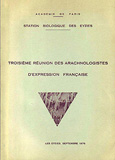 Darchen R. (ed) 1976:
Darchen R. (ed) 1976:
Comptes Rendus de la troisième Réunion des Arachnologistes d’expression française.
Station biologique des Eyzies, Académie de Paris.
Table of contents with separate PDFs
– Préface. 1 (PDF)
– Bonaric J.C., 1976: Impact de traitements hormonaux sur le déroulement des phénomènes de mue chez l’araignée Pisaura mirabilis Cl (Araneae – Pisauridae). 1–19 (PDF)
– Darchen R., 1976: La fondation de nouvelles colonies d’Agelena consociata et d’Agelena republicana, araignées sociales du Gabon. Problèmes éco-éthologiques. 20–39 (PDF)
– Emerit M., 1976: Quelques réflexions sur la trichobothriotaxie des aranéides. 40–51 (PDF)
– Goyffon M. & Vachon M., 1976: Étude pharmacologique de l’activité électrique spontanée des centres nerveux prosomiens du scorpion. 52–56 (PDF)
– Goyffon M., Vachon M., Le Pape G., 1976: Protéinogramme de l’hémolymphe en gel de polyacrylamide et hybridation interspécifique dans le genre Androctonus (Scorpionida, Buthidae). 57–61 (PDF)
– Heurtault J., 1976: Nouveaux caractères taxonomiques pour la sous-famille des Olpiinae (Arachnides, Pseudoscorpions). Note préliminaire. 62–73 (PDF)
– Juberthie C. & Manier J.-F., 1976: Les grands traits de la spermiogenèse chez les Opilions. 74–82 (PDF)
– Kovoor J., 1976: Caractères adaptatifs et caractères familiaux des glandes séricigènes dans le genre Hippasa E. Simon (Araneae, Lycosidae). 83–96 (PDF)
– Mahnert V., 1976: Quelques remarques sur les problèmes taxonomiques chez les Pseudoscorpions d’Europe et sur la structure des trichobothries des Pseudoscorpions. 97–99 (PDF)
– Morel G., 1976: Relations hôte-parasite dans les maladies du scorpions Buthus occitanus. 100–105 (PDF)
– Muñoz-Cuevas A., 1976: Structures dégénératives de l’oeil chez l’opilion cavernicole: Ischyropsalis strandi (Arachnida). 106–108 (PDF)
– Rambla M., 1976: Les Nemostomatidae (Arachnida, Opilions) de la Péninsule Ibérique III. Nemastoma dubium Mello-Leitao 1931. 109–114 (PDF)
– Ramousse R., 1976: Effets d’un facteur apériodique sur le comportement constructeur chez Araneus diadematus. 115–122 (PDF)
– Bonnet P., 1976: Le chant des arachnologistes. 123–125 (PDF)
2. ESA, Montpellier, France 1973
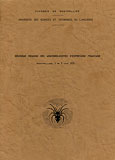 Legendre R. (ed) 1973:
Legendre R. (ed) 1973:
Comptes Rendus de la deuxième Réunion des Arachnologistes d’expression française.
Université des Sciences et Techniques du Languedoc, Montpellier.
Table of contents with separate PDFs
– Préface. 1–2 (PDF)
– Emerit M., 1973: Deux siècles et demi d’Arachnologie montpelliéraine. 3–6 (PDF)
– Boissin L., 1973: Étude ultrastructurale de la spermiogenèse de Meta bourneti Simon (Arachnides, Aranéides, Metinae). 7–22 (PDF)
– Christophe T., 1973: Premiers résultats obtenus à Montmorency (Val d’Oise) dans l’étude du peuplement d’Araignées d’une litière de taillis de châtaigniers, Castanea sativa L.. 23–25 (PDF)
– Darchen R.,1973: L’humidité dans les élevages d’Agelena consociata Denis. Perspectives écologiques. 27–36 (PDF)
– Juberthie C. & Juberthie-Jupeau L., 1973:– Sur l’ultrastructure des plaques paraganglionnaires de l’Opilion Trogulidae Trogulus nepaeformis (Scopoli). 37–43 (PDF)
– Kovoor J. & Zylberberg L.1973: Indices morphologiques d’un passage transépithélial de substances dans les canaux de glandes exocrines d’Aranéides. 45–55 (PDF)
– Krafft B., 1973: La tolérance réciproque chez les Araignées, un argument en faveur du rôle chemorécepteur de certains poils. 57–73 (PDF)
– Ledoux J.-C., 1973: Sur quelques araignées nouvelles ou peu connues de France. 75–77 (PDF)
– Muñoz-Cuevas A., 1973: Premiers stades de la différenciation du rhabdome chez l’embryon d’Ischyropsalis luteipes et remarques sur la théorie d’Eakin. 79 (PDF)
– Ramousse R., 1973: Le comportement constructeur: ses effets sur le développement des Araignées mâles d’un même cocon (Araneus diadematus Clerck). 81–97 (PDF)
1. ESA, Strasbourg, France 1972
Proceedings: not published.

